30 Days of Action: Sexual Assault Awareness Month 2023
April is Sexual Assault Awareness Month. In April and all year round, we believe survivors. We listen to survivors. We invite others to do the same. Studies show that at least 50% of trans/nonbinary people experience some form of sexual assault in their lifetime. These are staggering numbers. Throughout the month we’ll be posting 30 Days of Action for preventing and responding to sexual assault. Learn how you can make a difference each day by participating in 30 Days of Action!
Sun, April 30: Share something you found meaningful/helpful.
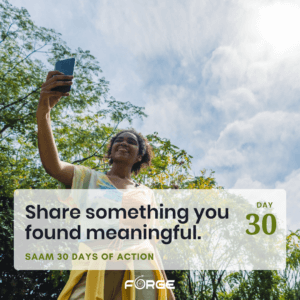 Today is the last day of April and the last day of Sexual Assault Awareness Month. However, our efforts to support survivors and end violence continue past this month. Take some time today, and any day in the future, to share with others something that you have found meaningful. It could be an action you took, a healing tool you used, or an idea for supporting others.
Today is the last day of April and the last day of Sexual Assault Awareness Month. However, our efforts to support survivors and end violence continue past this month. Take some time today, and any day in the future, to share with others something that you have found meaningful. It could be an action you took, a healing tool you used, or an idea for supporting others.
By sharing with others we build our own community networks and deepen relationships. We can listen and learn from those we love and be held and supported by them back. Further, we might help spread information that others don’t have. Through conversations, we can shift culture, engage resources, and take care of each other.
We also know that most people who experience sexual violence talk to a friend or family member before anyone else. By sharing information and resources on supporting trans/nonbinary survivors and ending sexual violence, we can better equip everyone in the community to support survivors. This would make it more likely that when someone discloses abuse, they are met with knowledgeable support and care.
What can you do?
Share on social media. Create your own post or share one of FORGE’s posts, something from NSVRC or another anti-violence organization.
Start a conversation about taking action to prevent sexual violence and support survivors. Check out Day of Action #25 “Start a Conversation” for more ideas.
Send someone a book, movie, or music recommendation that you found insightful.
Invite a friend to a healing space.
Make a note to yourself. Leave an affirmation, a suggestion, or a positive image somewhere you will see it. This way you’ll be able to connect to your own healing and support.
Sat, April 29: Speak up against harmful messages.
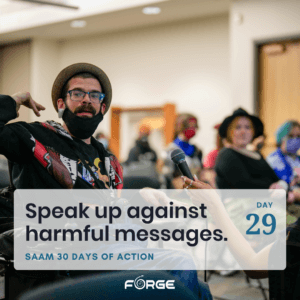 One way to make a difference is to intervene when harmful messages are being shared. These messages may be in the form of jokes, sharing misinformation, or intentionally harmful statements. The words that we use and the way we talk can impact our behavior and the behavior of those around us. Jokes that normalize sexual violence or diminish the impact of assault hurt all of us. Speaking up to challenge harmful messages demonstrates to others that you support trans/nonbinary survivors. It also can help someone change their mind or realize they were unintentionally causing harm.
One way to make a difference is to intervene when harmful messages are being shared. These messages may be in the form of jokes, sharing misinformation, or intentionally harmful statements. The words that we use and the way we talk can impact our behavior and the behavior of those around us. Jokes that normalize sexual violence or diminish the impact of assault hurt all of us. Speaking up to challenge harmful messages demonstrates to others that you support trans/nonbinary survivors. It also can help someone change their mind or realize they were unintentionally causing harm.
There is much misinformation about trans/nonbinary communities and survivors. Some people may share this without realizing what they are doing. This includes beliefs that someone might be responsible for being assaulted due to their gender(s), what they were wearing, or any other behavior, such as their employment.
Sadly, there are also people who will intentionally spread harmful or hateful messages.
There are many different ways to intervene when harmful messages are shared. To decide what to do, it can be helpful to first consider the situation. What is your relationship with the person? What could their intent have been? What capacity do you have?
What is your relationship with the person – do you know the person well? This could make it easier to have a longer conversation with them about the topic. Do you have a good, trusting relationship? You may want to rely on that trust and what you know of them to talk to them about what they said or did. If the person is a stranger – you may choose a shorter intervention because you have less of a relationship with this person.
What could their intent have been? It may be impossible to know another person’s intent. Someone may be better able to learn what you are sharing with them if you approach them as though they had good intentions. If it is clear that someone is trying to cause harm, it may be more useful to disrupt or show disapproval of the harmful message rather than try to change their mind.
What capacity do you have? It is okay to think through your capacity at the time. Perhaps you’d rather follow-up later. Perhaps you only have energy to say something short. Perhaps you feel ready to engage in a longer conversation. There are many choices you can make. It is not your job to respond to everything and it is helpful to intervene when you feel able and safe to do so.
What can you do?
Everyone:
Ask questions:
- “What do you mean by that?”
- “Where did you learn that? I’m curious because I’ve heard differently.”
- “What impact do you think that could have on survivors?”
- “Can you tell me more about why you think that?”
Say something:
- “That’s not funny.”
- “I know you didn’t mean it, but I find that language hurtful. I think saying ______ is a better way to say that.”
- “Please don’t say that.”
- “I’m going to go. I’m not comfortable around jokes like that.”
If hurtful jokes are being made, not laughing can send a loud signal to the person telling the joke, as well as others around, that you do not think the joke is funny. It can take practice to not react, smile, or laugh when people are trying to get you to do so. Some of us have learned to go along with others, sometimes as a strategy to stay safer. Take some time to practice your “that’s not funny” face.
You may also choose to leave a situation where harmful messages are being spread.
Fri, April 28: Take care of yourself.
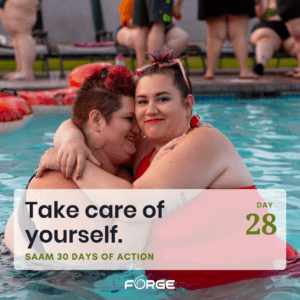 During Sexual Assault Awareness Month, increased discussion around sexual assault can feel empowering and connecting. At the same time, these discussions might bring up past traumatic memories, difficult emotions, or become overwhelming for trans and nonbinary survivors. It’s especially important for people with trauma histories to pay attention to what emotions are coming up, and to set aside time and space for self-care.
During Sexual Assault Awareness Month, increased discussion around sexual assault can feel empowering and connecting. At the same time, these discussions might bring up past traumatic memories, difficult emotions, or become overwhelming for trans and nonbinary survivors. It’s especially important for people with trauma histories to pay attention to what emotions are coming up, and to set aside time and space for self-care.
It may feel like there is a lot of pressure to talk about your story or take big steps towards a journey of healing (sometimes the path created by other people). Remember that rest is also healing, and resists a culture that demands being constantly busy or in action. Taking care of yourself means listening to what your body needs. It also means paying attention to how you’re feeling, taking breaks, and allowing yourself space and time to process your emotions–or to just do something you enjoy!
What can you do?
Everyone:
There are lots of ways to practice self-care. What is helpful, relaxing, and fulfilling may differ from person to person. Here are some different types of self-care, and ways to practice each.
Emotional self-care involves paying attention to, giving space for, and processing our emotions. Emotional self-care could include things like journaling, talking about your emotions with a trusted friend or family member, setting up a time to talk with a therapist or mentor, or practicing meditation. Emotional self-care can help us to feel more grounded, and attend to strong emotions that might make it difficult to feel present or connected with others.
Physical self-care focuses on listening to and taking care of your body. This might mean resting your body and taking a nap, doing some gentle movement like going for a walk/roll, stretching, eating a nutritious meal, or getting a massage or another form of bodywork. All forms of movement can help to improve mood and energy levels, as well as help with better sleep. You do not need to do a strenuous workout to feel these benefits.
Mental self-care involves activities that are intellectually engaging, like listening to a podcast, reading a book, or signing up for a class about a topic that interests you. This could also mean doing something creative, like painting, playing an instrument, or knitting!
Social self-care includes activities that help us feel connected to others and nurture our social relationships, which can help to prevent isolation. Some examples might include scheduling a phone call or a meet-up with a friend or family member, sharing a meal with someone, cuddling up with a pet, or even sending a text message or email to someone you care about.
Spiritual self-care means doing things that support your connection with spirituality. This will look different for different people, as some people may find this connection in a place of worship or by talking with a spiritual guide or leader, while others might prefer spending time in nature, reading about spirituality, or doing a personal another form of spiritual practice.
Practical self-care are activities that make our lives just a little bit easier. This could mean doing a load of laundry, checking your email inbox, cleaning up your space, or planning out your meals for the week. Sometimes, reducing clutter in our physical spaces can also free up mental energy for other things, and offer some ease in our daily routines.
These are just some starting points for practicing self care. For some other suggestions, check out this webinar on Self Care on a Budget: https://youtu.be/0c8212xvbMg
Thurs, April 27: Decriminalize sex work.
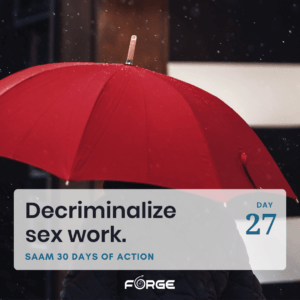 The 2015 US Trans Survey found that:
The 2015 US Trans Survey found that:
- One in five (20%) respondents have participated in the underground economy for income at some point in their lives such as sex work or drug sales.
The National Center for Trans Equality, The Red Umbrella Project, and Best Practices Policy released a report on the experiences of transgender people who engage in sex work. They write, “For many transgender people, the sex trade can offer greater autonomy and financial stability compared to more traditional workplaces, with few barriers to entry. However, economic insecurity and material deprivation can increase one’s vulnerability to harm and decrease the ability to make self-determined choices.
“Involvement in the sex trade remains highly stigmatized and stigma is compounded by other forms of discrimination, such as race, gender identity or expression, and class. People of color, immigrants, those engaged in outdoor sex work, and youth face the highest rates of police abuse and harassment, institutional discrimination, and violence. The consequences of stigma, targeted policing, and poor physical and mental health outcomes weigh heavily on already vulnerable communities.”
Kaniya Walker writes for the ACLU, “Laws that criminalize sex work push the industry underground, which makes it more dangerous. Sex workers face high rates of violence because clients assume they can assault or rob sex workers and get away with it. They take advantage of the fact that so many of us are afraid of reporting for fear of what will happen to us. If we call the police, we could be arrested for selling sex. We could also be abused by law enforcement.”
There are many misconceptions about sex work. Not all sex work includes the exchange of money. Some people also engage in sex work for food or a place to sleep. People of all genders have participated in sex work. It is important to recognize the economic factors that may contribute to someone doing sex work with out stereotyping or making assumptions about who is and isn’t a sex worker. Sex work is work. Sex workers have the right to work safely and not be arrested or judged for their work.
In addition to destigmatizing sex work, decriminalization would improve the lives of people engaged in sex work, people perceived to be sex workers, and everyone else. Decriminalization means repealing criminal laws for prostitution and related offenses and releasing anyone currently incarcerated for these crimes. Leading experts agree that decriminalization will protect the safety of people involved in sex work. Learn more about decriminalization and other efforts for the rights of trans/nonbinary sex workers with the Trans Law Center’s Trans Agenda.
Not only does it increase safety for those involved in sex work, decriminalization would help to:
- Reduce the number of non-violent offenders in jail/prison. Decreasing the number of people incarcerated saves resources and lives. It also helps communities to thrive by not disrupting family and social connections as severely.
- Recognize that sex work is just as valid as any other form of work. This would also help people to draw connections between different types of labor and advocate for better working conditions for everyone. Work involves exchanging our time, bodies, and thoughts for money. Everyone has the right to be safe at work and to have their needs met.
- Create a more sex-positive culture by destigmatizing peoples’ desires and needs for touch and sex.
- Challenge the idea that the government can control people’s choices about their bodies.
Check out 10 Reasons to Decrimalize Sex Work for more details.
What can you do?
Everyone:
Listen to and believe sex workers. Follow the lead sex worker advocacy groups. Learn about local and national efforts for the decriminalization of sex work. Pay attention to laws related to sex work – some things that claim to support sex workers actually make their lives harder. The Sex Worker Organizing Project is one of several organizations that amplify the voices and experiences of sex workers. The Global Network of Sex Work Projects put together this report on the the experiences and recommendations of sex workers here.
Don’t accept or joke about violence towards sex workers. Common statements like “I’m not a w****” or “I’m a drag queen not a hooker” contribute to the idea that there’s something wrong with sex work and with sex workers. Instead, invest in language and community that values everyone.
Join with decriminalization advocacy efforts.
Learn more from FORGE: https://forge-forward.org/resource/sex-work-and-violence/
Service providers:
Destigmatize sex work. Providers can do this by engaging in non-judgmental conversations with people about sex work. If it is necessary for your services to know what work a person does, consider naming sex work to people that you work with such as, “Many of our program participants engage in sex work or other street-based economies. We like to let everyone know that no matter how you make your money, you will not be judged here.”
Do not contribute to criminalization. Mandatory reporting laws do not require that you report adults engaged in sex work or other underground economies. Reporting can increase the danger to individuals and their families.
Respect the diversity of trans/nonbinary people’s experience with sex work and as sex workers. There is not just one type of work or experience with that work. If someone shares their experience, ask open-ended questions to learn what that work has meant to them.
Ensure services are offered that are appropriate and empowering. Do not assume that someone wants to leave sex work, and do not force that decision onto people. Individuals who do or have done sex work should not be automatically mandated to classes, assumed to need “saving,” or be pressured into any specific service. Unfortunately many services for sex workers have focused on pushing people to leave the industry and have required individuals to attend employment classes or classes about trafficking and exploitation. People should have access to resources if they want them, but it is critical to not assume that someone engaged in sex work is trafficked/exploited or in need of “economic literacy.”
Survivors and loved ones:
Connect with others to increase your community’s safety and support advocacy efforts. Safety planning can be helpful for sex workers. Consider sharing information with other workers about unsafe places and people. Identify someone who knows where you’ll be working and can check on you. Plan ahead for interactions with the police. Each person will have different safety needs in these situations.
Counter stigma. Remember that you have the right not be judged, harassed, or harmed for the work that you do.
Wed, April 26: End Gun Violence.
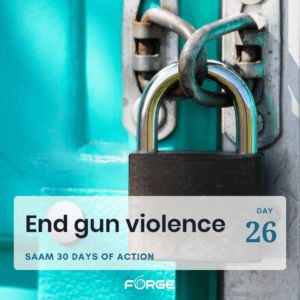 Please note that most research around gun violence uses law enforcement reports and databases. Statistics do not accurately capture various forms of gun violence due to systemic failures including under-reporting, marginalized populations not being adequately counted, racial bias, as well as the emergence of guns that are not trackable (ghost guns).
Please note that most research around gun violence uses law enforcement reports and databases. Statistics do not accurately capture various forms of gun violence due to systemic failures including under-reporting, marginalized populations not being adequately counted, racial bias, as well as the emergence of guns that are not trackable (ghost guns).
Gun violence research also does not accurately portray the experiences of trans/nonbinary people due to reporting tools not creating space for genders other than male or female. Data on LGBTQ+ people and gun violence, do not always separate out trans/nonbinary experiences from those of non-trans members of the LGBTQ community. The research below is some of the best that we could gather given these structural deficits.
We want to live in a world where kids, adults, and elders are safe. We want to live in a world where people can go to school, travel around their neighborhoods, shop at stores, play in parks, and be in their homes without fear of being shot. All of us – trans/nonbinary and not – have a stake in building that kind of safety for all of the communities we are a part of.
Gun violence has a devastating impact on all of our communities. 58% of American adults report they or someone they care for have experienced gun violence in their lifetime. Gun violence occurs in neighborhoods, through hate violence, mass shootings, and as part of intimate partner violence. The presence of guns increases the danger of fatality or serious injury for someone experiencing intimate partner violence, suicidal ideation, or interacting with law enforcement.
“The United States is not the only country with mental illness, domestic violence, video games, or hate-fueled ideologies, but our gun homicide rate is 26 times higher than our peer countries.” https://www.everytown.org/issues/mass-shootings/
The Williams Institute reports, “Guns were used in nearly 60% of bias-motivated homicides of LGBT people tracked by the National Coalition of Anti-Violence Projects in 2017. In addition to their role in intentional killings by others, firearms are widely used in suicides in the United States; firearms are also used to intimidate and threaten, and they can cause unintentional deaths and injuries.”
3 out of 4 homicides of trans people in the United States (that we know of) are committed with a gun. According to FBI data, in an average year, over 10,300 hate crimes in the United States involve a firearm—more than 28 each day. The vast majority of hate crimes are directed against people of color, religious minorities, and LGBTQ people. These numbers do not capture anywhere near the actual numbers of hate crimes and attacks, due in part to the reporting system used. Hate violence is increasing as well, making the actual annual numbers likely significantly higher.
LGBTQ+ people are more than twice as likely to be a victim of gun violence than their cisgender and straight peers (4.6 v 11.5 per 1,000).
One study found that victims of intimate partner violence are five times more likely to be killed if their abuser has access to a gun. (Note: this study focused on homicides of women, likely non-trans women though it did not specify. There is a significant gap in research on intimate partner homicides of people other than non-trans women). Nearly half of transgender people report experiencing intimate partner violence in their lifetime. The YWCA, in reporting on intimate partner violence, says, “Transgender women of color face an even higher increased risk of gun violence: transgender women are four times more likely to experience gun violence than cisgender women, and nearly 85 percent of transgender victims are women of color.”
These devastating statistics do not even touch upon the injuries caused by accidental use of firearms.
There are different opinions on the solutions to these issues. Some trans/nonbinary people advocate for stricter gun control measures. Some trans/nonbinary people support gun ownership for self-defense. Historically, gun control regulations have been enforced unevenly – with people who are often marginalized in society facing more punishment and more scrutiny than others. Language about “domestic terrorism” meant to encourage people to take the threat of violence within the United States more seriously has been used to increase surveillance and incarceration of communities of color, non-US born individuals, and trans/nonbinary communities.
It doesn’t have to be this way. We are in this together. We can come up with solutions that work, solutions that do not add to stigma, fear, or hate. When we look out for each other and invest in our communities, we build safety.
What can you do?
If you own or are around guns in your daily life:
- Learn gun safety. Consider taking classes on how to safely handle firearms.
- Keep any weapons securely away from people who do not know how to use them (like children) and people who are at risk for hurting themselves or others.
- Talk to your community about times it might be useful to move guns to safer places.
- For example, you may ask a friend to store guns in a different location when you and your kids spend the weekend with them. Or you might plan for someone else to keep the key to the gun safe if you worry that you may use your firearms in a harmful way.
- Learn how to safely get rid of firearms you no longer want.
- Safety plan – plan ahead to identify ways to avoid weapons if you are at risk of hurting yourself or others, or fear someone will use them against you.
Safety planning is a way for people being hurt by someone else, such as a partner, to plan ahead in order to try to increase their safety. If guns are around, these ideas may be helpful. It is important that you develop a plan that works for you based on your life and the risks you experience.
Safety Planning Considerations:
Location of firearms
- If you know the location, try to avoid that area when someone is acting harmfully or threatening towards you or others.
- If you don’t know where guns are located, try to find out, if possible.
Knowledge of firearms
- Gather information about the types of firearms, including their range, number of bullets they hold, and how easily they can be concealed.
- Learn about the person’s use of the firearms. Are they out at certain times? How capable is the other person of using the weapon?
- If possible, learn how to safely unload the gun.
Responding to danger
- Planning ahead for what to do if you are shot at, where to go, and how to get help, can increase your ability to respond in a crisis. This can include knowing the nearest emergency medical facilities, setting up speed dial on your phone for friends, or using a safety app to alert your support network to danger.
- Learn about what to do if you are shot and practice skills to stay calmer in an emergency.
The National Domestic Violence Hotline has more tips on planning for your safety here: https://www.thehotline.org/resources/safety-planning-around-guns-and-firearms/
Everyone:
Support survivors of gun violence. Check out The March for Our Lives policy plan as one example of survivors taking action.
Learn about the people and forces driving gun violence. By learning what upholds the massive rates of gun violence in the United States we can better create common sense solutions.
Support gun free spaces. Identify and create spaces in your community where there are no firearms. Many trans/nonbinary people do not feel safe around firearms. Creating gun-free spaces can be part of ensuring inclusivity, especially for survivors of violence. Our communities need gun-free spaces the same way we need sober spaces and child-friendly spaces. Having choice about where to spend time supports our communities.
Listen to each other. Many people have strong views on guns. These may come from our cultural backgrounds, our experiences with firearms, if we live in rural or urban areas, our life experiences, and our values. It is okay for our communities not to agree on everything. Listening deeply to each other can help us to better understand the fears, hopes, and beliefs of others. Through deep listening we may be better able to create community spaces and agreements that work for most everyone. This can happen in small groups – perhaps friends agree to keep guns away while certain friends visit – or in larger communities – perhaps by creating unarmed de-escalation at drag story time events.
Some communities may have trans/nonbinary focused gun safety classes or may have people accompany trans/nonbinary community members to classes in order for those to be more accessible.
Pay attention to gun control messaging. Be thoughtful with your language. Some gun control efforts are based on stigmatizing certain groups – such as saying that people with “mental illness” should not be able to buy guns. This vilifies entire communities and places the blame for violence in the wrong spot. Recently we have seen some politicians and others call for trans people to not be allowed to own guns. Language like “domestic terrorist” is often used against Black and brown communities, immigrant communities, and sometimes trans/nonbinary communities. This keeps us focused on specific individuals, rather than the larger picture of culture.
It is possible to support gun control without adding to myths that connect groups of people to violent behavior. Messaging might instead focus on keeping our communities safer, recognizing that some weapons should not be available to anyone, and so on.
Learn more about gun violence prevention efforts and how you can get involved.
Service providers:
Remember that you have the right to set boundaries for the spaces you maintain. This may mean having weapon-free environments. If people seeking services disagree, this is an opportunity for healthy conversation around boundaries.
Help people connect to a variety of tools and resources that can support their safety. Some trans/nonbinary survivors who express interest in gun ownership may not want to have a gun, but feel they have no other choices.
Learn about other self-defense options available locally or virtually that may be beneficial. Offer resources without judgment, “Have you considered taking a trans-affirming self-defense class? Do you think that is something that could help you feel more confident and safe?” Check out FORGE’s conversation with staff of Defend Yourself for more ideas.
Ask questions about firearms without judgement. This can help you to effectively build connection with people, learn about the risks in their lives, and meaningfully safety plan.
Tues, April 25: Start a conversation.
 Sexual Assault Awareness Month (SAAM) has been around since the 1970s. Trans/nonbinary people have always existed. There is still so much silence about sexual violence. There is also silence about trans and nonbinary people. For many, both subjects can feel taboo or filled with stigma. Neither sexual violence or trans issues are shameful or in need of being kept in the dark. Bringing these topics into conversation can help break the stigma and humanize both sexual violence and trans people.
Sexual Assault Awareness Month (SAAM) has been around since the 1970s. Trans/nonbinary people have always existed. There is still so much silence about sexual violence. There is also silence about trans and nonbinary people. For many, both subjects can feel taboo or filled with stigma. Neither sexual violence or trans issues are shameful or in need of being kept in the dark. Bringing these topics into conversation can help break the stigma and humanize both sexual violence and trans people.
Conversations can help survivors find support, can move us all away from shame and victim-blaming, and can increase connections within communities. Conversations can help us help a friend.
You might start with a conversation about something you’ve learned or taken action on during SAAM. It might be sharing a social media post or FORGE’s 30 Days of Action. Check out hashtags like #SAAM2023, #PreventionDemandsEquity, or #TransSurvivors for ideas.
We can learn new things about what we believe by listening to and reflecting on what we hear from others. By talking with each other we can better understand each other and increase a common language. We can help each other to learn and grow, which may also include challenging harmful social norms – about sexual assault and/or about trans people and communities.
What can you do?
Service providers:
Be thoughtful about conducting universal screening for experiences of violence. Be sure that your screening is universal – people of all genders and sexualities can be the victims/survivors of violence. Far too often trans/nonbinary people and cisgender men are left out of screening. Ask questions in private. Do not ask about experiences of violence in front of the person’s companion, as that may keep the person from sharing. Ask in a way that supports disclosure. “Many of our patients have experienced some form of violence or harm in their lifetime. I ask all of my patients these questions every year. Do you feel safe at home? (wait for answer) Has anyone ever done something sexual to you that you did not want?”
Service providers can also share information for people to share with their friends and family. “I like to make sure everyone I work with knows about the local rape crisis hotline. It’s more likely that someone will share their experiences with friends or family, and this way you have the resources to share with them.” Futures Without Violence, GLAMA, and FORGE, created a great palm card intended for providers to hand out to their clients. Consider ordering some directly from Futures or from FORGE.
Community members:
Starting a conversation can be as simple as, “I heard about this resource I didn’t know about. Can I tell you about it?” It may be talking about a song or TV show. “Did you see last night’s episode? What did you think of the way those two characters got together? I thought it was so cool how they took their time and talked about things. That was refreshing to me.” Or “Have you heard that new song by our favorite artist? Damn, the way the song talked about how their parents interacted was really harsh. I dunno about you, but my parents never acted that way. What was your parent’s relationship like?”
Survivors:
If you want to start a conversation about your own experiences, you have every right to ask for what you need and see if the person you want to talk to is able to meet those needs. You also get to decide what you do and do not feel comfortable sharing. To start a conversation you might say something like, “I want to tell you about some things I’ve experienced. It’s hard for me to do. Do you have an hour when we can talk without distractions?” or “I’d like to sit next to you and hold your hand while I tell you what happened. But making eye contact will be hard for me. Is that okay?” or “I don’t need advice right now. I just want you to listen. Does that work for you?”
Traumatic experiences can make trusting and connecting with ourselves and others more challenging. Many survivors find it hard to ask for anything that they need, even when it is not related to potentially painful subjects. You may find that acknowledging that can help. You could say, “It’s hard for me to ask for things sometimes, so this feels awkward. I don’t actually want pizza for dinner, even though I said yes to it. Can we get tacos?”
If you don’t feel comfortable talking, you can still start a conversation by asking someone else a question. This can be a great way to build trust and connection with others while feeling less vulnerable personally. Ask about what interests the other person or ask their thoughts on a topic that interests you. You might say, “It seems like bird watching is really popular. Have you gotten into any new hobbies recently?”
Sometimes starting a conversation, especially one you feel worried about, can be easier if you have a plan for exiting the conversation. You could set an alarm so that you know you will have an excuse to leave in ten minutes. You may say at any time, “Actually, I need to take a break. Let’s catch up later.” Some people find knowing these options ahead of time takes the pressure off the conversation.
Mon, April 24: Safe housing for all.
 Housing should be a human right. People need places to sleep, eat, bathe, keep their things, and relax that are safe. Without this, it can be much harder to keep a job, continue with education, manage addiction or a mental or physical health crisis, or take care of ourselves and our families. Unfortunately, not everyone has safe housing. For many trans/nonbinary people housing is not available or accessible. (Skip ahead a few paragraphs if you find the statistics too overwhelming).
Housing should be a human right. People need places to sleep, eat, bathe, keep their things, and relax that are safe. Without this, it can be much harder to keep a job, continue with education, manage addiction or a mental or physical health crisis, or take care of ourselves and our families. Unfortunately, not everyone has safe housing. For many trans/nonbinary people housing is not available or accessible. (Skip ahead a few paragraphs if you find the statistics too overwhelming).
According to the U.S. Trans Survey from National Center for Trans Equality (NCTE), 1 in 5 trans people have experienced discrimination in housing searches and 1 in 10 have been evicted due to gender identity. Further 1 in 5 trans people have experienced homelessness in their lifetimes. Somewhere between 20-40% of homeless youth are LGBTQ+ – with the exact rates of trans youth being unknown. One in five adults report being physically or sexually assaulted while homeless. In an earlier study 38% of homeless or marginally housed transgender people reported either physical or sexual victimization in the previous year, with 11.9% reporting sexual assault and 33.3% reporting physical assault. These numbers are higher than those of non-trans people.
Compounding this issue is the fact that for many people homeless services and shelters are not safe – OR accessible to trans/nonbinary people. According to the US Trans Survey just under 85% of transgender and nonbinary people experiencing homelessness avoided sheltering systems entirely because of fear of mistreatment and harassment by staff or other residents. Of those who sought shelter, 41.4% were denied it, with 29.8% being openly denied shelter due to their gender expression. 44% reported experiencing mistreatment at a shelter in the past year.
Other studies demonstrate that not only are there high rates of sexual violence for people who are unhoused, there are also high rates of violence in homeless shelters. Seventeen percent of people who identify as transgender were sexually assaulted while staying in a homeless shelter. Black and multiracial transgender people reported higher rates of sexual assault at shelters than white transgender people. Transgender women were more likely (26%) than transgender men (15%) to report sexual assault at shelters.
On average, trans/nonbinary people also make less money and have less in savings, which impacts choices in housing.
FreeFrom, an organization that provides financial support to survivors, analyzed the demographics of survivors they funded. In FreeFrom’s most recent report, “Support Every Survivor”, they found that: 42.2% of trans survivors did not have access to consistent or safe housing, a rate of 2.1x that of cisgender (non-transgender) survivors. 41.5% of gender non-conforming or nonbinary survivors did not have access to consistent or safe housing, a rate of 2x that of cisgender survivors.
Safe housing for all is a piece of the violence prevention puzzle as well as a tool for supporting survivors of violence. Everyone should have access to safe, quality housing.
Why is this true though? Here are a few of the reasons.
- Lack of housing increases risk of experiencing sexual violence. People living in shelters or on the streets experience more sexual assault.
- Unstable housing increases family stress. This in turn can make it harder for families to provide high levels of support. Having stable, nurturing family/caretaker support is shown to protect against perpetrating violence in the future.
- Abusive people may use housing and economic resources as a means of control, keeping people in relationships with partners or family that commit sexual abuse because there is nowhere else to go or no way to safely have the abusive person kept out of the home.
For even more information, check out Prevention is Safe Housing for All.
Housing alone will not prevent all sexual violence. Many people are assaulted in their homes by friends, partners, or family. Homes should be places where we are safe. They are not that way for far too many people right now. Safe housing for everyone would help to prevent a great deal of sexual violence and would provide a critical support for survivors.
When survivors do want to or need to relocate, all survivors should be able to access safe, supportive shelter services and relocation assistance. Despite federal regulations that protect against gender discrimination, most services are not equitable for trans/nonbinary people.
Housing helps those who have already experienced sexual violence. Survivors deserve safe places to heal and take care of themselves. Recovering from trauma can be an intensive process. Many people who experience trauma find themselves feeling less stable, less in control of their emotions, and having more difficulty connecting with or trusting others. The stability of housing, of not having to worry about everything that comes with a lack of housing, can mean one less thing that people have to worry about. Trauma survivors may find that the impacts of trauma affect their abilities to keep and maintain employment, friendships, and control of their health. Without stable housing, survivors are at increased risk of losing their housing if these other supports are also lost.
In our current reality, safe housing is not accessible for everyone. Rent prices have been skyrocketing the past few years. Affordable, safe housing is harder and harder to find. Trans and nonbinary people are at higher risk of being unhoused or having unstable/unsafe housing. Trans youth of color face especially high rates of homelessness. This happens because of individual discrimination – parents kicking kids out, landlords refusing to rent to people, and employers not hiring trans people or only hiring for poorly paid positions. This also happens because as a society we don’t guarantee people housing and don’t have adequate protections against discrimination. Historic redlining and racist housing policies as well as the lack of control over rising rents, predatory lending, and other policies make safe housing inaccessible to so many people.
What can you do?
Service providers:
Help people access housing. Help survivors stay in their homes if they want to. So much funding goes to relocation assistance, but many people do not want to or can’t relocate. Trans people may live in areas because they are the safest places for them, because of access to community, healthcare, or other services. Same with disabled folks. It’s important to value peoples’ autonomy – and that often is making it possible for people to stay in their current housing. You can help by provide funding to change the locks, build a fence, or turn the lights back on.
Help find new safe housing. Some survivors will want or need to move, especially if the home is a trauma-reminder or trigger. Remember that everyone deserves housing that meets their needs. With higher rates of disability in trans/nonbinary communities, recognize that many people may require specific types of housing or housing in certain areas (such as on public transportation routes). Those needs often aren’t negotiable.
Learn about how to make shelter environments more accessible and inclusive for trans/nonbinary people. Check out these resources to get started.
- Sexual Violence Housing Resource Collection
- Equal Access for Transgender People: Supporting Inclusive Housing and Shelters
- FORGE has an extensive collection of resources on shelter.
Advocate for safe places for people to go any time of the day or night. Advocate for rent control and affordable housing. Help create additional protections for trans/nonbinary people against discrimination in housing and employment. All of these efforts will help communities – not just individuals – to be safer.
Survivors:
Know your rights. Housing and victims’ rights vary from state to state. NCTE has compiled many resources that can help you navigate your legal rights. Check them out here: https://transequality.org/know-your-rights/housing-and-homeless-shelters
Remember that you have the right to housing. Not being able to find housing or employment or struggling with money are all sources of shame for many people. However, they don’t need to be. Housing isn’t affordable for many people now. You are not to blame for a systemic problem.
It is okay to ask for help. Everyone deserves support. You can be strong, tough, resourceful, and still seek out support. Whether it’s from a social service agency that can help you navigate housing resources and laws, or from your local community to gather money for a rental deposit, know that it is okay to ask for help.
Sun, April 23: Support incarcerated trans people.
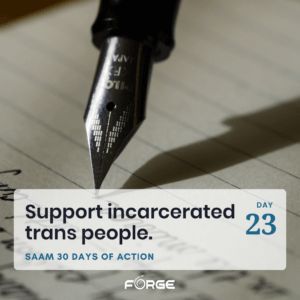 Nearly one in six transgender Americans—and one in two Black transgender people—has been to prison. Further research from the US Trans Survey showed that transgender people are ten times as likely to be sexually assaulted by their fellow inmates and five times as likely to be sexually assaulted by staff. Respondents to the US Trans Survey in 2015 reported that twenty-two percent (22%) of respondents who were incarcerated in jail, prison, or juvenile detention in the past year reported that they were physically and/or sexually assaulted by other inmates during that time. One in five (20%) respondents who were incarcerated in jail, prison, or juvenile detention in the past year were physically and/or sexually assaulted by facility staff during that time.
Nearly one in six transgender Americans—and one in two Black transgender people—has been to prison. Further research from the US Trans Survey showed that transgender people are ten times as likely to be sexually assaulted by their fellow inmates and five times as likely to be sexually assaulted by staff. Respondents to the US Trans Survey in 2015 reported that twenty-two percent (22%) of respondents who were incarcerated in jail, prison, or juvenile detention in the past year reported that they were physically and/or sexually assaulted by other inmates during that time. One in five (20%) respondents who were incarcerated in jail, prison, or juvenile detention in the past year were physically and/or sexually assaulted by facility staff during that time.
This is not the end of the mistreatment transgender prisoners face, which also includes being denied medical care and lengthy stays in solitary confinement.
Research shows that most people who are incarcerated have experienced violence prior to incarceration, including sexual violence. By supporting incarcerated people, we are supporting survivors.
Check out the National Center for Trans Equality’s resources for trans/nonbinary people and for advocates, service providers, and employees of the criminal/legal system.
What can you do?
Everyone:
Check out these resources on supporting incarcerated trans/nonbinary people: https://forge-forward.org/day-16-incarcerated/
Know your rights and share information on legal rights with others: https://legacy.lambdalegal.org/know-your-rights/article/trans-in-prison-faq
Advocate for policies that decrease incarceration and policing. These can include efforts to change extreme sentencing, move funding towards social supports and away from policing, and efforts for more data transparency from the criminal/legal system. Some policy efforts may increase the role of prisons or police in our communities, which can be harmful. This chart can help you assess policy efforts and their potential impact.
Service providers:
Learn about providing meaningful services to incarcerated people. Just Detention International and FORGE have created several resources to get you started:
Sat, April 22: Pay attention to your feelings.
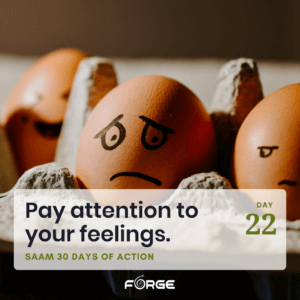 We’re all born with emotions, but many of us struggle to identify and talk about what we’re feeling. Even when we can, the range of language we have to describe emotion may be limited. Expanding our emotional vocabulary and being able to talk about our emotions is particularly helpful for trauma survivors so that we can communicate our needs, get support from others, and make sense of what’s happening in our bodies and minds. Sharing what we’re feeling with others can help to reduce feelings of isolation and shame.
We’re all born with emotions, but many of us struggle to identify and talk about what we’re feeling. Even when we can, the range of language we have to describe emotion may be limited. Expanding our emotional vocabulary and being able to talk about our emotions is particularly helpful for trauma survivors so that we can communicate our needs, get support from others, and make sense of what’s happening in our bodies and minds. Sharing what we’re feeling with others can help to reduce feelings of isolation and shame.
Recognizing our feelings is also a powerful way to build healthy relationships with the people in our lives. When we aren’t aware of or can’t express what we’re feeling, it’s easier to lash out at others, withdraw from social contact, or use coping mechanisms to distance ourselves from our emotions, like drugs or alcohol. Sharing our emotions is vulnerable and difficult, but can lead to feelings of connection and intimacy with the people we care about.
Honoring what we feel is an important part of self-care. When we can name what we’re feeling, we’re better able to take breaks from stressful situations or experiences, take care of our bodies with nutritious food, movement, and rest, and feel connection and empathy from the people in our lives.
What can you do?
Survivors and community members:
Sometimes, it’s hard to describe what we’re feeling. Getting more specific helps us to communicate what we feel and need to others, and allows us to have more clarity about how to practice self-care. One way to gain clarity about our emotions is to start with the broader words we have to describe emotions, like “sad,” “happy,” or “angry,” and then use a tool like this emotion wheel to narrow down to a more specific feeling.
These are a few resources that might be helpful to explore:
This video discusses how emotion wheels can be especially helpful for survivors. (While the video specifically talks about childhood sexual abuse, this tool can be useful for survivors of all kinds). https://youniquefoundation.org/resources-for-child-sexual-abuse-survivors/healing-from-child-sexual-abuse-trauma/emotion-wheel/
Try this meditation called “Beauty of the Needs,” which invites you to reflect on what feelings come up when needs are met or unmet: https://youtu.be/Db74D0vS60k
Visit page 91 of this self-help guide for healing from sexual assault to learn about the 5 stages of emotions (how emotions flow and constantly change, even if they feel like they’re going to last forever) and strategies for “being a witness to your emotions”: https://forge-forward.org/wp-content/uploads/2020/08/self-help-guide-to-healing-2015-FINAL.pdf
Visit page 68 of the self-help guide for some easy techniques for regulating strong emotions: https://forge-forward.org/wp-content/uploads/2020/08/self-help-guide-to-healing-2015-FINAL.pdf
Read Loree Cook-Daniels’s blog post on emotional connections: https://transsurstage.wpengine.com/2022/09/06/emotional-connections/
Fri, April 21: Support your local trans/nonbinary community.
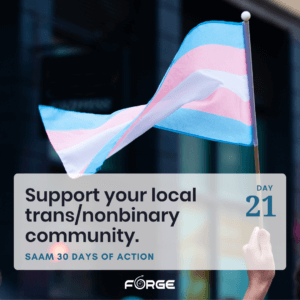 Trans/nonbinary people are everywhere, in every community. Across the nation and the world there are many urgent issues facing trans/nonbinary communities and everyone. Looking at the news can be overwhelming as we learn about climate change, housing crises, challenges to healthcare, harm happening to immigrant communities, attacks on trans/nonbinary rights, natural disasters and more. Many of us care a lot about the world, but may not be sure where to start. As the old bumper sticker says, “Think globally, act locally.”
Trans/nonbinary people are everywhere, in every community. Across the nation and the world there are many urgent issues facing trans/nonbinary communities and everyone. Looking at the news can be overwhelming as we learn about climate change, housing crises, challenges to healthcare, harm happening to immigrant communities, attacks on trans/nonbinary rights, natural disasters and more. Many of us care a lot about the world, but may not be sure where to start. As the old bumper sticker says, “Think globally, act locally.”
Taking action in your local community can make a big difference. Donating $5 or an hour of your time to a smaller organization might be more meaningful than doing the same to a national organization with a huge budget. Showing up at local events, supporting trans-affirming businesses, and helping out your neighbor makes real change in people’s lives.
What can you do?
Survivors and loved ones:
Join with others to create a resource directory of trans/nonbinary affirming services in your area. Some people have used private social media groups to gather this information, others more formal meetings or discussions. Share recommendations with people who ask. Consider making your own list of resources and supports. It might help to write down places that feel safe to visit – because they are trans-affirming, have accessible bathrooms, or any other reason. That can make it easier to find places when you want them.
Service providers:
Let people know that you provide trans/nonbinary-affirming care. If you are not currently connected with local trans/nonbinary communities, check out this resource on outreach: https://ovc.ojp.gov/sites/g/files/xyckuh226/files/pubs/forge/tips_outreach.html
Everyone:
Pay attention, when possible to local issues. School boards, county commissions, city councils, and other local governments make a big difference in people’s day to day lives. Some cities are considering offering additional protections for trans people against discrimination. School boards influence the books and materials young people have access to, including trans/nonbinary inclusive materials. Speaking up locally can be influential. This might mean speaking at events, voting in local elections, joining with others for various causes.
You may want to volunteer for a local organization. Many places could use support with everything from tabling at festivals, to stuffing envelopes, to fundraising, or cleaning a park. If there aren’t existing organizations to support, you can still support local community. This may look like helping drive neighbors to vote, sharing meals with trans/nonbinary people nearby, offering to take someone to the grocery store, or other acts of daily kindness.
Public displays of support can make a big difference. Putting up stickers, yard signs, or window decals shows the trans/nonbinary community that you support them and it lets everyone know what some of your values are. Many trans/nonbinary people, especially in small towns, have noted that seeing someone with a pronoun pin or trans flag at the local hardware store has been incredibly affirming for them.
Thurs, April 20: Have trans/nonbinary affirming conversations about sex, bodies, and relationships.
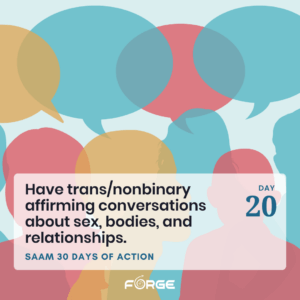 Learning about the diversity of human bodies, reproductive healthcare, sex, genders, and sexuality(ies). Learning from early ages about open communication related to bodies and sexuality is critical to developing positive relationships with ourselves and others. Without access to affirming conversations on these topics – conversations that reflect a wide array of identities and experiences – people may learn from TV, movies, social media, ads, peers, and what they see around them. These lessons are less likely to emphasize consent and active communication. They are also less likely to depict bodies that the majority of us have – fat, smooth, skinny, hairy, boney, curvy, fragrant, asymmetrical, and so much more variation.
Learning about the diversity of human bodies, reproductive healthcare, sex, genders, and sexuality(ies). Learning from early ages about open communication related to bodies and sexuality is critical to developing positive relationships with ourselves and others. Without access to affirming conversations on these topics – conversations that reflect a wide array of identities and experiences – people may learn from TV, movies, social media, ads, peers, and what they see around them. These lessons are less likely to emphasize consent and active communication. They are also less likely to depict bodies that the majority of us have – fat, smooth, skinny, hairy, boney, curvy, fragrant, asymmetrical, and so much more variation.
Everyone has a right to understand how their own body works and to know about the ways that other types of bodies work. Currently, there are many efforts to deny young people this information in schools. The effects of anti-trans, anti-LGBTQ+, and anti-reproductive freedom legislation(s) are far reaching, in some states going so far as to prevent children from talking about menstruation. While in other states, legislation is forcing kids to disclose the dates of their bleeding cycles in order to “prove” they are not trans girls. Some places still deny the existence of intersex people through a rigid and inaccurate description of sex as binary, and through medicalized systems that reinforce that binary.
Education about sex and bodies can also be connected to conversations about relationships. These should include topics like consent, communication, positive relationships, and the wide variety of relationship structures that humans have. It is important for people to learn that not everyone experiences sexual or romantic attraction. Not everyone wants or will have monogamous relationships. Polyamorous relationships are just as positive and healthy as monogamous ones. As people learn more about sex, it is important that there be a focus on pleasure and consent. Discussions of sex should not be limited to only one or two ways that bodies can fit together. All of these discussions help people to grow up with less shame and judgment.
Many parents want their children to have accurate, age-appropriate information, but may not have the skills or knowledge themselves to provide this education. Part of the solution is providing comprehensive sexuality education in schools.
The Future of Sex Education Initiative defines comprehensive sexuality education as: “Sexuality education programs that build a foundation of knowledge and skills relating to human development, relationships, decision making, abstinence, contraception, and disease prevention. Ideally, comprehensive sexuality education should start in kindergarten and continue through 12th grade.
At each developmental stage, these programs teach age-appropriate, medically accurate information that builds on the knowledge and skills that were taught in the previous stage. Future of Sex Education Initiative, 2012, p. 39”
When thinking about educational programs, consider how people will learn about bodies, health, reproductive healthcare, sexually transmitted infections and protections available, consent, relationships, communication, different sexualities and genders, and more.
The National Sexual Violence Resource Center has compiled some of the research connecting sex education and primary prevention of sexual violence in this study. In addition, research shows that some sex education programs can be effective in preventing perpetration of child abuse by working with adolescents to understand their responsibilities to not commit harm.
Quality sex education programs promote effective communication, consent, respecting boundaries, and challenge social norms related to violence and gender.
Check out more resources around sex education programs and standards here:
- Sex Education Collaborative Toolkit
- New National Sex Education Standards
- Webinar: How Healthy Sexuality Education Can Change Social Norms
Learn about the work of Advocates for Youth around sex education, including checking out a quality curriculum.
What can you do?
Talk to people about sex and bodies, with their consent, of course! It is appropriate for little kids to know the anatomical terms for body parts. By speaking clearly about bodies and being inclusive of the wide range of bodies that exist, we can help destigmatize our bodies, sex, and healthcare. Knowing the terms for different forms of genitals may also help little children tell someone if they do experience abuse or harm. As children grow and learn, they may ask that different terms be used to refer to their own anatomy. It is important to also respect this language. For example, an adult should not insist to a child that a body part is a penis if the young person states it is their clitoris.
As children grow older, knowing about puberty and being able to ask questions and express concerns will continue to help people to have a less stigmatized or shame-based relationship to their bodies. This is also helpful for all kids to be able to better understand and explore their own relationship to their body and their gender(s)- something that proves life-saving for many trans/nonbinary children. This open communication supports young people to understand and more clearly be able to share with supportive people what kind of puberty they do or do not want to experience. This will create opportunities to explore affirming healthcare services, such as puberty-blockers.
Talk about relationships, consent, and, as age-appropriate, sex. People are exposed to these concepts in the media. Communities can take part in shaping inclusive, consent-based norms around relationships and sexuality. Young people who understand sex and can ask questions about it are more likely to have positive sexual experiences. Being able to talk about sex also improves the ability to talk about things that aren’t sex but may be sexual – like assault and violence. This helps survivors get the support they need.
Improve access to trans/nonbinary affirming sex, health, and relationship education. Sex education should include information about the wide variety of bodies, genders, sexualities, and relationships that people have. It should emphasize consent and communication. Research shows this can help prevent violence by giving people the tools to communicate and be aware of their own behavior so that they do not cause harm.
Books for kids:
Check out your local library, if accessible. If they don’t have the books you want, many libraries have a process for patrons to request that they purchase specific books.
Local LGBTQ community centers are another great resource for books. In some places community-based education programs are available. For example, Unitarian Universalist Churches offer a sexuality education program called OWL: Our Whole Lives. These programs often have an accompanying library and you don’t necessarily need to be a member of the church to participate. Learn more at: https://www.uua.org/re/owl
If available in your area, check out a drag story hour. Many of the performers read affirming and fun books. This may also be a great way to meet other parents or bookstore staff and ask for their tips. Drag story hours are also a beautiful way to share with children the wide range of genders and gender expressions that exist and to meet people with different types of bodies, voices, and experiences. Children benefit from reading about and meeting people who reflect the wide range of humans in our world.
Whenever possible, read books with your kids or read the book before you give it to your kid. This can help you talk about it later. Not every book will perfectly align with the messages you want to send, so you may want to know what to bring up.
These book lists provide some examples of the books available about gender, bodies, and consent for younger children.
- Early Childhood Books About Gender Diversity
- 21 Picture Books About Consent and Bodily Autonomy
- Sex Education Books for Kids by Age
Consider checking out books by trans/nonbinary authors. Though these books may not be specific to education about bodies or relationships, they provide young people (and adults) an opportunity to hear from a wider range of perspectives. These resources have books by and about trans/nonbinary people:
Wed, April 19: Connect with your neighbors and communities.
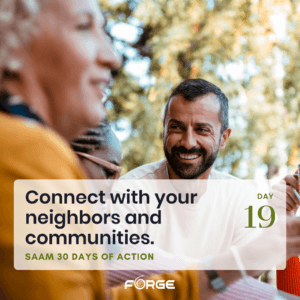 Communities where people are connected to each other in positive, meaningful relationships have less interpersonal violence and are then, also, able to get quality services to survivors of violence faster. This is type of dynamic is called community connectedness. It is a protective factor against multiple forms of violence, including sexual assault. The Centers for Disease Control and Prevention (CDC) has gathered resources on risk and protective factors that you can check out here: https://vetoviolence.cdc.gov/apps/connecting-the-dots/
Communities where people are connected to each other in positive, meaningful relationships have less interpersonal violence and are then, also, able to get quality services to survivors of violence faster. This is type of dynamic is called community connectedness. It is a protective factor against multiple forms of violence, including sexual assault. The Centers for Disease Control and Prevention (CDC) has gathered resources on risk and protective factors that you can check out here: https://vetoviolence.cdc.gov/apps/connecting-the-dots/
We can all take action to connect with our neighbors and communities. Casey Keene from The National Resource Center on Domestic Violence writes about her experiences in community here. Check out the article for more information on beloved community, mutual aid, and the connection to violence prevention.
Connection can look like:
- Sharing food
- Checking on one another
- Sharing rides to the store
- Feeding a neighbor’s dog while they are at work
- Playing soccer in the street
- Helping someone get home safely
- Smiling and saying hello while out walking
- Support parents
To learn more, check out this resource about health equity, connecting with community, and sexual violence prevention: https://www.nsvrc.org/sites/default/files/2021-06/health_equity_approach_to_preventing_sv_final508_0.pdf
Prevent Child Abuse has gathered resources on how supporting parents in our communities can help prevent violence. Many trans/nonbinary people are parents or involved in the life of children. Check out their ideas here: https://preventchildabuse.org/resources/strengthening-protective-factors-in-your-community/
What can you do?
Everyone:
Learn about connecting with others and forming meaningful relationships. This webinar, though focused on COVID, gives many great ideas for building connections:
https://forge-forward.org/resource/creating-meaninful-relationships/
Reach out to others around you. Check out this post for ideas:
https://forge-forward.org/day-15-closer-place/
Demonstrate your support for trans/nonbinary communities. Check out this post for ideas:
https://forge-forward.org/day-10-yard-signs/
Learn about actions that can be taken in schools, workplaces, and communities:
Tues, April 18: Make your paperwork inclusive.
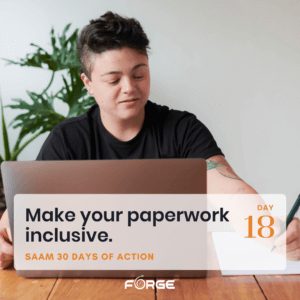 When someone sets up a first appointment with a therapist, doctor, or other service provider, intake paperwork is often the first introduction they have to that agency or clinic. When trans and nonbinary survivors see that intake paperwork reflects their identities, and clearly explains why certain information is needed, they can pursue the services they need with more confidence that they will be seen, respected, and affirmed for who they are.
When someone sets up a first appointment with a therapist, doctor, or other service provider, intake paperwork is often the first introduction they have to that agency or clinic. When trans and nonbinary survivors see that intake paperwork reflects their identities, and clearly explains why certain information is needed, they can pursue the services they need with more confidence that they will be seen, respected, and affirmed for who they are.
Having inclusive paperwork encourages survivors to be able to accurately describe their life, identity, and experiences. This might include relationship status, the name of a partner or a close contact, gender, sexual orientation, and more. Inclusive paperwork doesn’t just benefit trans and nonbinary survivors; it also leaves more space to represent the diverse experiences of anyone who walks through the office door to receive services.
What can you do?
Service providers:
Include fields on paperwork for people to share the name and pronouns they want you to use, and encourage agency-wide use of these fields (for example, so that a client checking in with a receptionist can use their current name without having to provide a legal name).
Explain why you’re asking. Many trans people are asked invasive questions about body parts, sex assigned at birth, if they have had surgery, or their sexual orientation. If you need to know this information, explain why it’s relevant to their care, and explain that these fields are optional if not absolutely necessary.
Ensure that paperwork is private and confidential. If paperwork needs to be shared with anyone besides you and the client or patient, make this clear upfront.
Consider whether your forms only include binary options. If it’s relevant to your practice, are the only gender options “male” and “female”? Is there a place for people to write-in additional identities? Here are some examples of less binary and more trans-affirming gender fields on intake forms.
For medical practices, consider using an “organ inventory.” Organ inventories allow patients to select all of the body parts (often reproductive organs and secondary sex characteristics) they have and may need care for. This is helpful for trans people who have various configurations of body parts that may not be apparent based on appearance, and non-transgender people (for example, a cisgender woman who has had a mastectomy or hysterectomy).
Learn more about organ inventories, and asking questions about sexual practices and health in this webinar on reproductive healthcare for trans and nonbinary people: https://youtu.be/IlkbmKLbjPc?t=1124
Similar to organ inventories, some service providers may use “body maps” with clients seeking care after an assault or during a forensic exam. Non-gendered body maps leave space for trans and nonbinary survivors to accurately describe their experiences.
For more in-depth considerations about paperwork for forensic exams, check out this webinar: https://youtu.be/ZyGuDBxcgnU?t=2834
Learn more about inclusive paperwork: https://www.gsrc.princeton.edu/creating-inclusive-forms
Survivors:
You have a right to work with providers who know about trans people and have paperwork that reflects that awareness. You have a right to have your identity captured correctly on intake forms, including spaces for you to share your name of use, your pronouns, your partnership(s), your sexual orientation, or any other core parts of your identity.
One of our earlier action items this month was “go with a friend to an appointment.” Having someone there with you, who is willing and able to help advocate for you if forms are not inclusive, can take the pressure off of you having to address this yourself.
While some people may feel comfortable bringing up non-inclusive forms with a provider, you should not be expected to do this while accessing the care you need. If you encounter paperwork that does not include your experiences or identity, one alternative is to write an anonymous letter to the provider or agency. This allows for some distance—to not have to raise concerns while you’re getting care—and protects your privacy. Writing to share your experiences and how more inclusive forms would better represent your identities would make it easier and more comfortable for you to access care can encourage providers to update their paperwork.
Mon, April 17: Advocate for policies that help survivors and promote equity.
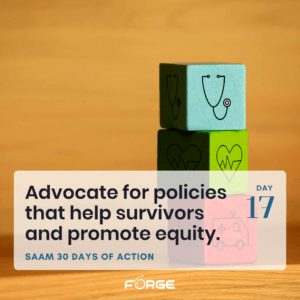 Research shows that many policies that can help make survivors’ lives easier also are connected to preventing violence. In fact, many of these policies would make life better for everyone. There are actions that governments, companies, and individuals can take to increase economic equity – to make sure that everyone has the resources they need and to decrease the gap between the wealthiest and poorest.
Research shows that many policies that can help make survivors’ lives easier also are connected to preventing violence. In fact, many of these policies would make life better for everyone. There are actions that governments, companies, and individuals can take to increase economic equity – to make sure that everyone has the resources they need and to decrease the gap between the wealthiest and poorest.
As the Movement Advancement Project reports, “Pervasive discrimination and a lack of legal protections mean that transgender people struggle to find work and safe housing, face challenges updating critical identity documents, make less on the job, and have higher medical costs than their non-transgender peers.”
Policy change can work to create more economic security for everyone, including trans/nonbinary survivors. Increasing the minimum wage/creating a living wage and creating pay equity – so that people of all genders and races get paid the same for the same work – helps survivors by increasing financial resources which can help people to make choices about their situations and get the support they need. These types of policies also demonstrate that as a culture we value everyone. This can work to decrease harassment and discrimination.
Having paid leave policies in the workplace means that survivors can get physical and mental healthcare, as well as take care of their families without losing money. Paid family leave policies help families create nurturing connections with their children and should be available to parents of all genders at the same rate. Family leave policies help families provide care across the age span and provide support for people caring for elders. Some states have paid domestic violence leave which covers time off for court dates or other needs related to surviving domestic violence. However, these protections are not available to everyone.
Policies could also increase supports specifically for survivors. Many financial assistance programs for survivors of violence, such as Crime Victims Compensation, are currently attached to filing a police report in nearly every state. This may not be the safest option for many survivors. Trans/nonbinary survivors of sexual violence need access to healthcare, financial assistance, mental health services, and other forms of support without having to engage with law enforcement. Access to healthcare, including screenings for sexually transmitted infections, medications including post-exposure prophylaxis, assessments for internal injuries (particularly after strangulation), abortion care and Plan B, should all be freely available.
What can you do?
Everyone:
Learn about the policies in your area. Ask organizations what policies they are advocating for. Often there are already existing efforts to make change that you can join in on. Not all policy determinations come through legislation, for those who can’t or do not feel comfortable lobbying. Boards of health and education, school boards, businesses, and other governmental and non-governmental organizations create policy and funding decisions that impact all of us.
Write letters, make phone calls, speak at hearings – engage in whatever way feels comfortable and safe for you.
FreeFrom has developed reports and action steps on creating economic supports for all survivors.
Service Providers:
Share research and evidence-based programs with decision-makers. Look at the policies you have control over. You may have mandates from funding sources – how can you enact these policies in ways that support inclusion and the well-being of survivors and fulfill the requirements of your funder or institution? For example, investigate if you provide sex-segregated services how they best serve trans/nonbinary communities and how your services can be genuinely equitable across all genders. FORGE has several resources available on this topic here: https://forge-forward.org/resources/service-providers-2/?tf=shelter&rtf=&lf=&af=
Engaging in informed consent models of care is another way to support trans/nonbinary survivors through organizational policy.
Sun, April 16: Take action for trans/nonbinary rights.
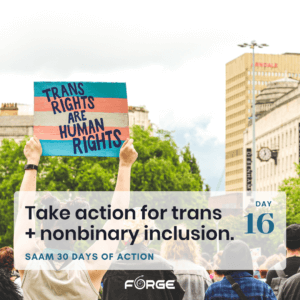 The past few years in the United States there has been a strategic effort by some politicians and hate groups to exclude trans/nonbinary people from society. These public policy efforts have happened alongside an increase in hate-based violence and discrimination. By advocating for trans/nonbinary rights in all aspects of our society, we can help prevent violence, support survivors, and make a safer world for all of us.
The past few years in the United States there has been a strategic effort by some politicians and hate groups to exclude trans/nonbinary people from society. These public policy efforts have happened alongside an increase in hate-based violence and discrimination. By advocating for trans/nonbinary rights in all aspects of our society, we can help prevent violence, support survivors, and make a safer world for all of us.
Today we invite everyone to think about what it would mean for trans/nonbinary people to be able to meaningfully take part in all aspects of society.
Some politicians are leading positive efforts by proactively protecting trans rights and access to healthcare through legislation. Community-based organizations are working to ensure that neighborhoods, schools, and businesses affirm and support trans/nonbinary people. This may be through ensuring equal access to facilities (like bathrooms), opportunities (like employment and participation in sports), and fair treatment (like housing). All of us have opportunities to take action in big and small ways for trans/nonbinary rights.
What can you do?
Everyone:
Learn more about state-sanctioned hate by watching FORGE’s webinar on the topic: https://forge-forward.org/resource/state-sanctioned-hate-the-impacts-of-the-culture-wars-on-trans-lives/
Take steps to be inclusive all year-round. Legal protections are critical, and our behavior matters. By working to address any unconscious biases and to include trans/nonbinary people, we can create a culture of equity that is supported by legal protections. FORGE provides some examples of micro-inclusions here: https://forge-forward.org/day-30-microinclusion/
Service Providers:
There are many resources on FORGE’s website to assess your services. Check out the tools for service providers here.
Take opportunities to support efforts for trans/nonbinary rights. This may include helping survivors to know their rights (check out SAAM day 6), signing letters of support for advocacy efforts, or joining with others to create change.
Sat, April 15: Learn about transformative justice and other non-carceral approaches to holding people who commit acts of sexual violence accountable.
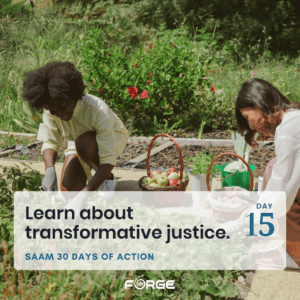 Many survivors want alternatives to police and the criminal legal system for accountability. According to the National Center on Transgender Equality’s research, half of transgender people report they are uncomfortable seeking police assistance. More than one-fifth (22%) of transgender people who had interacted with police reported police harassment, and 6% of transgender individuals reported that they experienced bias-motivated assault by officers. Black transgender people reported much higher rates of biased harassment and assault (38% and 15%).
Many survivors want alternatives to police and the criminal legal system for accountability. According to the National Center on Transgender Equality’s research, half of transgender people report they are uncomfortable seeking police assistance. More than one-fifth (22%) of transgender people who had interacted with police reported police harassment, and 6% of transgender individuals reported that they experienced bias-motivated assault by officers. Black transgender people reported much higher rates of biased harassment and assault (38% and 15%).
The threat of harm that can result from involvement with these systems, to the survivor or the harm-doer, can keep people from seeking out the support and services they want. At the same time, many survivors also want the person who caused them harm to be held responsible for their actions and to not hurt anyone in the future. ValorUS explores what survivor-centered transformative justice can look like here.
Transformative Justice is an approach that seeks to transform the conditions, behaviors, and beliefs that led to the violence, support the survivor’s ongoing safety and well-being, and prevent future violence by the harm-doer. To learn more about transformative justice and its history, check out this overview: https://transformharm.org/tj_resource/transformative-justice-a-brief-description/
The article We Keep Us Safe: The Transformative Justice Movement is about some of the history of the transformative justice movement in the United States, including how trans/nonbinary communities have always been a part of this work.
The National Resource Center on Domestic Violence wrote about the connections between transformative justice and primary prevention of domestic violence here: https://vawnet.org/news/how-can-advocates-better-understand-transformative-justice-and-its-connection-gender-based
Transformative justice can sometimes seem very far away from the world that we live in now. It asks for us to use our imaginations to create alternative ways of interacting with each other. Ultimately transformative justice looks like building a world that values everyone. The We Choose All of Us campaign from Idaho provides a beautiful example of what this world can look like.
What can you do?
Everyone:
Learn more about transformative justice. There are many online resources, books, and videos available. You can also learn by talking to others. Ask questions about what justice and accountability mean. Consider your own answers to these questions. Resources to learn more:
Transformative Justice Law Project
Beyond Survival: Strategies and Stories from the Transformative Justice Movement
Learn about some of the thought leaders of transformative justice movements. Here are a few to get you started: Mia Mingus, Leah Lakshmi Piepzna-Samarasinha, Ejeris Dixon, and Mariame Kaba.
Check out examples of transformative justice in action with Creative Interventions.
Build community. Strong connections with others can help us hold each other lovingly accountable. Learn about pods and pod-mapping. The Bay Area Transformative Justice Collective describes developing the language of pods, “We needed a term to describe the kind of relationship between people who would turn to each other for support around violent, harmful and abusive experiences, whether as survivors, bystanders or people who have harmed. These would be the people in our lives that we would call on to support us with things such as our immediate and on-going safety, accountability and transformation of behaviors, or individual and collective healing and resiliency.”
During the pandemic, many of us have started to use the term pods to refer to groups with which we share risk. For some people there may be overlap between these two groups of people (our pandemic pods and the people we’d turn to for support and safety).
FORGE has a webinar on pods and mutual aid. This recording shares the benefits of pods in helping us to build connections with others and get our needs met. Relationships with others that help all of us through mutual aid can help create the foundation for pods connected to transformative justice.
Learn to have generative conflict. The Wildfire Project describes generative conflict as, “Engag(ing) conflict in ways that generate more possibilities, greater connection, and fuller expression, instead of shutting those things down.” Conflict is a normal part of the human experience, however many of us have not been taught the skills to engage in conflict respectfully and while maintaining relationships. By moving through conflict, instead of avoiding it, we can better address underlying issues and build stronger connections.
Learn accountability for your own actions. We live in a culture that often teaches us we have to be “perfect.” This makes it hard to admit that we have made mistakes. However, all of us are learning all the time. Taking responsibility for our actions, sincerely apologizing, and working to change our behavior is a part of being human and growing.
Fri, April 14: Create supportive environments.
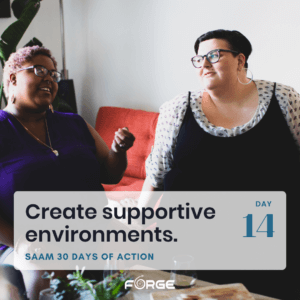 The places and spaces that we live, work, and play in have a big influence on our lives. The physical structures can help us to feel included, such as wheelchair ramps, comfortable lighting, access to green spaces/nature. The physical spaces might make us feel excluded, like when there are confusing hallways, lack of windows, bars or other security measures that communicate exclusion. Our environments also are created by the cultures and attitudes communicated by the space. Think about a time that you entered a room or building and felt welcome. What about the space let you know you were welcome?
The places and spaces that we live, work, and play in have a big influence on our lives. The physical structures can help us to feel included, such as wheelchair ramps, comfortable lighting, access to green spaces/nature. The physical spaces might make us feel excluded, like when there are confusing hallways, lack of windows, bars or other security measures that communicate exclusion. Our environments also are created by the cultures and attitudes communicated by the space. Think about a time that you entered a room or building and felt welcome. What about the space let you know you were welcome?
Research shows that our environment has an impact on us. Access to green spaces can help prevent violence. Seeing trees can reduce stress. Having clean, safe parks to play in promotes connections in communities and may enhance childhood development. By thoughtfully designing neighborhoods, cities, and towns, we may be able to decrease multiple forms of violence.
Supportive physical environments in schools and businesses can help students to learn and maintain employee well-being. In schools, fear, bullying, discrimination, and hunger are among the many things that may prevent children from engaging with teachers and other students, or from learning effectively. Safe, supportive school environments are ones that work to prevent these harms through both the attitudes and behaviors of staff as well as through the physical environment.
A similar process happens to adults at work and in the community. Our sense of safety impacts our mental and physical health. Communities that are built to support connection, safety, and access to resources can prevent these harms. Likely, this is a major part of why protective environments prevent violence.
When a space – be it a home, school, or neighborhood – encourages safety, support, and nurturing it is a protective environment. This means that the environment is helping to prevent violence with the way it has been designed. When people feel safe and supported in the places they are in, they are better able to participate in their communities. Protective environments are also supportive of survivors, even when those environments may not recognize that they are being trauma-informed and healing-centered.
There has been a lot of work done to understand universal design, trauma-informed spaces, and trans/nonbinary inclusive spaces. In addition to learning about this work, it is important to listen to the voices and needs of the people using a space.
One school-based prevention program, Shifting Boundaries, is most effective because the program asks students where they feel safe and unsafe in school and why. The administrators and staff then take action to change the school environment based on feedback. This may include changing emergency protocols, increasing lighting or supervision in certain areas, or changing where students spend their free time. Because the perspectives of youth are at the center of the work, not only is it more effective in helping young people feel safer, but it also teaches everyone involved to listen to youth.
GSAs and other trans-affirming student groups can serve a similar function at schools by creating spaces for students to share what they want and need.
In Indiana, the Indiana Coalition Against Domestic Violence worked with a number of community groups to understand how to make neighborhoods safer and more inclusive for people with disabilities. Isolation is a risk factor for domestic and sexual violence. By increasing connection and making the area easier to navigate, people with disabilities were less isolated.
In Sexual Citizens, researchers looked at experiences of sexual assault on a college campus to develop environmental approaches to prevent future violence. Their recommendations included creating late-night, alcohol-free spaces for people to hang out, increased transportation options, and decreasing the difference in resources available to new students and older students.
In all of these approaches it is critical to listen to the experience of survivors. The violence is not the fault of the survivor and did not happen because of anything the survivor did or did not do. Still, survivors have knowledge, skills, and insights to offer on how to stop future violence. There is still more work to be done to prevent sexual violence against all people, and we know even less about the specific prevention strategies for trans/nonbinary people. Protective environments are likely different for trans/nonbinary people. Because we rarely ask trans/nonbinary survivors for insights, we have less information on how we can all better create those environments. However, there is also a lot we can start doing now.
Learn more about some of the work happening to create protective environments in schools for LGBTQ youth here:
What can you do?
Everyone:
Learn more. Identify what role you might be able to take in shaping your community. This could mean joining neighborhood or town efforts, thinking about your own workplace policies and environments, or even your home. Consider what places help you feel safe and included. How can you work to make more spaces that feel supportive?
Listen to and learn together with other people. No one person or community has all of the answers, but together we can create a safer world.
Survivors:
Remember that you have the right to safety and supportive environments. You may not feel comfortable in all the places you have to go. You have a right to ask for (or state) specific things that help you feel safer – for example, “I’d like to sit in that chair so I can see the door;” “Could we turn on the overhead lights?;” or “Would you please sit a little farther away from me?.” If you don’t feel comfortable asking, you might be able to find ways that help increase supportive-feeling environments. For example: arriving early to class so you can pick the seat where you feel safest in the room; scheduling first of the day appointments with a therapist, so you have less concern about bumping into others; or inviting friends over for dinner instead of going out to eat.
Service providers:
Consider the environment you work in. There is a lot to consider in creating supportive and inclusive environments, because people have so many diverse needs. Often adding in opportunities for choice can make a big difference. For example – can people choose where to sit from a variety of chairs or couches? Can people easily adjust the temperature? Do people have an option of sitting in a waiting area with others, or in a more private or quiet room? Do an assessment of your workspace. How is it supportive for trans/nonbinary communities and survivors? What can you change?
Many of the practices of trauma-informed care align with creating a supportive environment. By offering safety, choice, empowerment, and transparency, service providers can decrease retraumatizing survivors. A self-assessment of your workspace can help identify opportunities to strengthen trauma-informed care. Learn more about how the physical design of spaces can support healing here.
These two resources provide examples of trauma-informed practices in LGBTQ communities: https://www.lgbtqiahealtheducation.org/wp-content/uploads/2020/06/9e.-Trauma-Informed-Care.pptx.min_.pdf
https://lgbtqequity.org/wp-content/uploads/2021/06/Trauma-InformedCare-Final.pdf
Learn more about providing services to people with disabilities: https://www.endabusepwd.org/resource/providing-accessible-and-effective-services-to-survivors-of-sexual-assault-with-disabilities/
Learn more about safety for survivors here: http://www.preventconnect.org/wp-content/uploads/2017/07/2017_PC_ConferenceSummaries_010818-2-1.pdf
Learn from FORGE about becoming a trans-welcoming agency by checking out these introductory resources:
https://forge-forward.org/resource/trans-welcoming-environment-a-tips-sheet/
Thurs, April 13: Support multiple pathways to healing.
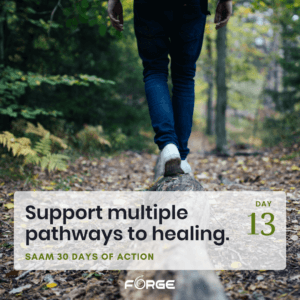 There are many ways to heal from sexual abuse or assault. Many people don’t access resources for healing until many years after an assault, and there is no right or wrong timeline for healing. Therapy is a common resource that many people access for healing, but it is one of many options someone might explore as a part of their healing process. Although therapy should be available and affordable for everyone, this isn’t the reality. Finding a therapist who is both trans-affirming and trauma-informed can be challenging, especially when some therapists have long waitlists or require referrals.
There are many ways to heal from sexual abuse or assault. Many people don’t access resources for healing until many years after an assault, and there is no right or wrong timeline for healing. Therapy is a common resource that many people access for healing, but it is one of many options someone might explore as a part of their healing process. Although therapy should be available and affordable for everyone, this isn’t the reality. Finding a therapist who is both trans-affirming and trauma-informed can be challenging, especially when some therapists have long waitlists or require referrals.
There are also many types of therapy modalities. What works well for one person may not be a good fit for others, so it often takes time and trying different approaches to therapy to find something that works. For example, some types of therapy, like psychodynamic therapy, focus heavily on identifying the origins of a problem or challenge. Other types of therapy, like cognitive behavioral therapy and acceptance and commitment therapy, focus on shifting ways of thinking and changing behaviors. Some people may also try group therapy or working with a partner in therapy, as these modalities can have different dynamics than the traditional one-on-one approach.
Survivors may seek out other pathways to healing, either in addition to, or in place of traditional talk therapy. For example, some people find reading self-help books, creating art, practicing mindfulness and meditation, body or energy work, medication, or movement/exercise helpful for healing. Some people turn to trusted friends and family members for support, while others seek advice and belonging with faith communities or leaders. All people are different and what they need for healing is different, as well.
What can you do?
Survivors:
Learn about different alternatives or additions to therapy, and see what sounds helpful to you. You may want to try several different approaches to see what fits well. Remember that it is completely your choice about whether or not to seek therapy or other services, when you look for support, and what strategies you try for healing.
Sometimes, what’s helpful for healing changes over the course of someone’s lifetime. You might find that something you once found healing as a resource is no longer helping. This may be an indication that it’s time to explore other options and strategies.
Only you can know if or when it’s time to seek support from a therapist, or try other alternative strategies for healing. It may be helpful to use a checklist like this one to think about how sexual assault or trauma are impacting your life and what you would like to work on or like to see change, either through therapy or other modalities. Talking about your goals for healing with a trusted support person may help to get clarity about how you would like to move forward.
Service providers:
Be aware of alternatives or additions to therapy that may be useful for survivors so that you can make referrals informed by an individual’s preferences, experiences, and needs. Learn about what kinds of alternative therapies, like bodywork, art therapy, support groups, or mindfulness services may be available in your area, and share this information with survivors. Remind clients that there are many different pathways to healing, and that healing looks different for everyone.
Be mindful that many trans survivors have had negative experiences with service providers. Acknowledging this to clients can help to affirm that you understand where they are coming from and have done your homework.
Wed, April 12: Go with a friend to an appointment.
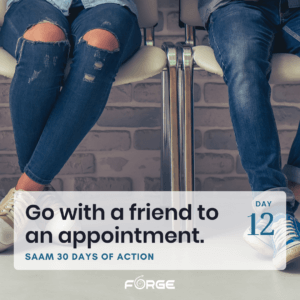 After experiencing sexual abuse or assault, getting services can be overwhelming – including services that are not directly related to the assault. Having a friend by your side can make the process easier, by reducing transportation barriers, decreasing the likelihood of harassment, providing moral and emotional support, and having someone to advocate for you to get the care you need. Going along with someone can make a big difference in their life.
After experiencing sexual abuse or assault, getting services can be overwhelming – including services that are not directly related to the assault. Having a friend by your side can make the process easier, by reducing transportation barriers, decreasing the likelihood of harassment, providing moral and emotional support, and having someone to advocate for you to get the care you need. Going along with someone can make a big difference in their life.
What can you do?
Everyone:
Let your friends know how you can support them, if you’re able. Do you have access to a car to help someone get to an appointment? Do you have free time during the day that you can go with someone?
Talk ahead of time about what specific things your friend may need support with at an appointment. Someone might appreciate help with getting checked in and having someone to wait with them, but then might want to go into the appointment alone. Others may want someone with them during the whole appointment. It may be helpful to take notes about what a provider is saying so that the person can refer to it later, when they might not be able to absorb all of the information at once. You might also talk about specific questions or concerns they would like you to raise if they forget or feel uncomfortable.
Additionally, having someone there to advocate for someone’s correct name and pronoun usage can take that weight off of someone who is already stepping out of their comfort zone to get support.
Service providers:
Find out what policies are in place at your agency around allowing support people to be involved in an appointment, therapy session, or consultation. Inform clients or patients who may not be aware that they can bring a support person with them.
Tues, April 11: Ask for consent.
 Consent is a critical part of preventing sexual violence and providing trauma-informed care. Many people have not been taught how to ask for consent, how to respond to being told no, and how to tell what is and isn’t consent. All of us have the responsibility to think about the way that we treat others, in and out of relationships, to ensure that we are engaging in healthy dynamics and acting with consent. By modeling consent in all of our actions, we can be a part of the work to teach others about having safe, positive relationships.
Consent is a critical part of preventing sexual violence and providing trauma-informed care. Many people have not been taught how to ask for consent, how to respond to being told no, and how to tell what is and isn’t consent. All of us have the responsibility to think about the way that we treat others, in and out of relationships, to ensure that we are engaging in healthy dynamics and acting with consent. By modeling consent in all of our actions, we can be a part of the work to teach others about having safe, positive relationships.
Everyday actions for consent help all of us learn that asking for consent is a normal part of life. That can make it easier to do in sexual/romantic situations. Furthermore, the more we ask for consent, the more we get used to people answering and get practice setting our own boundaries.
Remember, whether you struggle to set boundaries or not, it is never your fault if someone assaults you!
What can you do?
Everyone:
Ask for consent, not just during sexual or romantic situations, but all of the time. This might sound like, “Would you like a hug?,” “I have some questions, is now a good time to chat?,” “I would like to get to know you better, is that something you’d like?,” or “The first step of this exam is for me to place the stethoscope on your back. Is that okay?” Consent is for everyone!
Learn the difference between “yes” and “no” and respond respectfully. “Yes” may come with additional requests such as, “Yes, you can examine my back, but can you warm up the stethoscope a little?” or “Yes, I can chat for ten minutes – is that enough time or should we wait?”
No may look like: no response at all, the word “no,” “I’m not sure,” “ummm,” or any number of other things that are not an unequivocal yes. One easy way to respond to “No,” is by saying “Okay, thank you for letting me know.” This shows that you have heard the person and you appreciate their boundary. Depending on the situation and your relationship you may have additional conversations. It is important that you do not show anger towards the person or keep asking until they say yes. These tactics can be coercive, even if you don’t mean them to be, and may make it hard for someone to give you a truthful yes.
Engage in self-reflection. Consider how you respond when someone tells you “no.” Does it feel like rejection? Do you want to change their mind? Many trans/nonbinary people have experienced a lot of rejection. This can make “no” hard to hear, as it might remind us of past negative experiences. Take time thinking by yourself or discussing with your community how you respond when someone tells you no.
It is also helpful to spend time considering your own boundaries. Are there things that help you to feel more confident when setting a boundary? Is it hard for you to say no? What can you do to identify and name your boundaries?
Parents and those interacting with children can model consent and encourage it in children. For example, when you are playing a game with kids– like tickling or chase– stop immediately if they say or otherwise indicate stop. Modeling your respect for their “stop” will help them learn to respect others when they say no, too. Check out books that teach children to respect the bodies and choices of others, such as “C is for Consent.”
Service providers:
Ask consent for the different stages of your work– whether it’s medical exams, advocacy, therapy, or paperwork. Many trans/nonbinary people may use different words to describe their body than you may be used to. Consent includes finding out what words a person wants you to use. Consent for service providers may also take on the additional role of helping clients/survivors understand what they might be consenting to. Informed consent is a phrase many people use, but may not implement fully. Share with clients why you are asking for specific information, or why you are recommending a specific action or potential solution, or why you need them to fill out certain paperwork. Explaining why information is needed, or behaviors may happen, helps build rapport and trust, as well as letting the client know you will respect their boundaries and limits in other situations, as well.
Mon, April 10: Reduce sexual harassment.
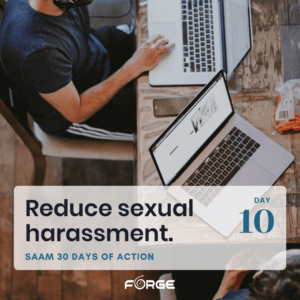 Sexual harassment is damaging to people’s well-being and safety. Some harassment escalates into assault. Everyone deserves to be safe in any environment, including their workplace. Unfortunately, some of the most rampant sexual harassment at work takes place at lower paid jobs. Reducing sexual harassment means holding people responsible for their actions when/if they harass others, making sure that victims and bystanders can report harmful behavior and be taken seriously, encouraging a safe and supportive environment, and ensuring that people are able to leave their jobs if they need or want to. Sexual harassment has a negative impact on people’s economic opportunities. Check out this article for more (note: the research focuses on women, though the impacts on trans/nonbinary communities are similar).
Sexual harassment is damaging to people’s well-being and safety. Some harassment escalates into assault. Everyone deserves to be safe in any environment, including their workplace. Unfortunately, some of the most rampant sexual harassment at work takes place at lower paid jobs. Reducing sexual harassment means holding people responsible for their actions when/if they harass others, making sure that victims and bystanders can report harmful behavior and be taken seriously, encouraging a safe and supportive environment, and ensuring that people are able to leave their jobs if they need or want to. Sexual harassment has a negative impact on people’s economic opportunities. Check out this article for more (note: the research focuses on women, though the impacts on trans/nonbinary communities are similar).
Providing well-paid job opportunities, having universal healthcare so that people can leave jobs without losing benefits, and other steps for economic equity could increase the ability of people to leave unsafe working conditions. Many people, particularly in low-wage jobs, do not have the resources to change employment or to pursue legal avenues of support. Similar to preventing any form of sexual violence, it’s imperative that those causing harm are held accountable for their actions and that harassment is discouraged by the work culture.
Thirty percent (30%) of transgender and non-binary individuals who are employed report experiencing problems or discrimination at work each year. Many trans and non-binary employees feel there is not much, if anything, they can do to counter this difficult situation. That’s actually not true. FORGE has compiled resources for trans/nonbinary communities on workplace rights related to harassment and retaliation. Information is available in webinar format and in tipsheets. All of these resources are collected at https://forge-forward.org/publications-resources/sex-harassment/.
What can you do?
Survivors:
Check out the resource above for information on your rights at work. Seek support so that you don’t have to navigate the harassment alone. You deserve to be safe everywhere in your life, including the workplace. It can be difficult to decide what to do though. While retaliation for reporting harassment is supposed to be illegal, it does still happen. Many trans/nonbinary people have difficulty finding alternative employment, so many hold onto jobs that have unhealthy, unsafe, or harassing environments. Loved ones or service providers may help you safety plan and get emotional support.
Service providers:
Sexual harassment, in the community and/or at work, can have a major impact on a person’s health and well-being. Experiences of sexual harassment may come up in mental or physical health services. Be supportive and trauma-informed with your response. Remember that like other types of sexual violence, no one deserves to be harassed and the victim/survivor did not cause it.
Look at your workplace policies. Make sure your workplace has a clear anti-harassment policy that is reinforced by the workplace culture. Making sure that jokes aren’t targeted towards demeaning any person or group; promoting communication and encouraging people to voice discomfort all create an environment where harassment cannot thrive.
A quick reminder: No one should touch others without their overt consent. This holds equally true for employers, staff, and program participants.
Sun, April 9: Learn bystander intervention.
 Everyone can play a role in preventing sexual violence. Bystanders are people who witness something harmful. Active bystanders, sometimes called upstanders, are people who intervene in some way in what’s happening to try to minimize or prevent harm. Often people report they did not intervene because they did not know what to do. Bystander Intervention gives people practical tools to use to be able to take action.
Everyone can play a role in preventing sexual violence. Bystanders are people who witness something harmful. Active bystanders, sometimes called upstanders, are people who intervene in some way in what’s happening to try to minimize or prevent harm. Often people report they did not intervene because they did not know what to do. Bystander Intervention gives people practical tools to use to be able to take action.
Many bystander intervention programs use some version of “The 5 Ds: Direct, Delegate, Distract, Delay, and Document.” These four actions give people options to choose from when deciding what to do. Remember that your safety is important and so each person can choose from the tools available to them based on the situation. These tools are meant for people not involved in the harmful incident that is occurring.
Direct. Directly say or do something to stop the harm. This might be saying, “Hey, that’s not cool.” If you are able to speak with the individual at risk privately (away from the harm-doer), ask them directly if they need or want help. You can offer specific ways you could help, such as to stay with them, assist them in getting somewhere else, or calling someone to help.
Delegate. Delegate means getting help from others. This can look like telling the bouncer at a bar that someone is acting harmfully. Or it can look like involving adults to help when a young person is being hurt. Delegate may mean tell someone to run and get help or call a friend to give someone a ride. There may be many situations, especially for trans/nonbinary people who are witnessing an event when we don’t feel safe taking action to intervene directly. Delegate can be a good option to bring in additional support or find someone better equipped to handle a specific situation.
Distract. Distraction can interrupt a harmful incident and give the person being targeted an opportunity to escape or deescalate. Distraction may involve giving anyone involved something else to focus on. Some distractions may be more engaged – like interrupting a conversation to ask for the time or to ask one person to show you where the bathroom is. Some might be less direct– honking a horn, drawing everyone into a group activity at a party, asking everyone to clear the dance floor so that something can happen. These all can shift the focus away from the incident and may give the person being targeted the chance to physically move away from the potential harm-doer.
Delay. Delay slows down what is happening. This can create space for tensions to decrease. In some situations, the potential harm-doer may use a pause to reassess their actions and choose not to cause harm. A delay can also be helpful for the person at risk. They may be able to leave the situation, reach out to someone for additional support, or just have a moment to make the choice that is best for them. . Try to act in a way that can delay the harm from happening. For example, you may witness someone trying to pressure someone else to leave a party with them. Delay could involve engaging the person doing the pressuring into a conversation. This could give the other person a chance to find a different ride or go meet with another group of safer people. .
Document. Finally, there are some situations when it may be helpful to document what is happening. You might discreetly record the event on your phone, take notes about what is happening, or take a picture. The victim/survivor may be able to use the documentation to get support later on or to prove what happened. Survivors may be overwhelmed and stressed, having a difficult time remembering what happened. Some potential harm-doers will avoid causing harm if it is being documented. Try to first assess the situation to ensure that someone is helping the person at risk. If not, determine if there is any way you can use one of the other approaches to decrease the harm. Additionally, do not post the documentation online without the survivor’s permission.
What can you do?
Service providers:
Learn bystander intervention and conflict de-escalation techniques. These can help you and your team intervene in a wide array of situations that may happen at your organization. By promoting community-based de-escalation techniques and intervention, you can help make your organization safer.
Businesses, especially bars, restaurants, and event spaces:
Ensure your whole team/staff are trained in bystander intervention. Plan together with the team how to respond to harmful situations. Help people understand how sexual misconduct is inappropriate and can escalate. There are many organizations that provide bystander intervention training. Ask about their programs, specifically for their understanding of racism, anti-trans actions, and any cultural considerations for your space (ex: differences in bar culture between gay bars and predominantly straight bars). Some programs will be better able to help your team navigate bystander intervention in an equitable way.
Everyone:
Think ahead about how you can take action in different situations. Practice in your head or with others, so that it doesn’t feel awkward when you are in a situation that benefits from intervention. Share ideas on bystander intervention with friends and family. Having a plan before something happens allows us to be better able to take action in the moment. If you notice you feel uncomfortable thinking about or taking action, take time to reflect on what keeps you from intervening.
Resources to learn more:
Right to Be, bystander intervention trainings: https://righttobe.org/
NSVRC Tipsheet: https://www.nsvrc.org/sites/default/files/2018-02/publications_nsvrc_tip-sheet_bystander-intervention-tips-and-strategies_1.pdf
FORGE webinar on supporting bathroom safety: https://forge-forward.org/event/bathrooms-bullies-and-bystanders-webinar-dec2020/
Sat, April 8: Learn about and share local and national resources.
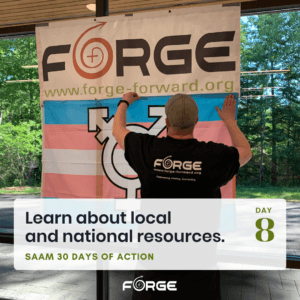 There are many people and organizations working to support trans/nonbinary survivors of sexual violence. Today we invite everyone to learn about and share information on both local and national resources.
There are many people and organizations working to support trans/nonbinary survivors of sexual violence. Today we invite everyone to learn about and share information on both local and national resources.
While we know that our communities can provide much needed support, it may also be helpful to seek out additional services. Some types of services offer legal protections, like confidentiality or victim-advocate privilege. Others may have access to specific resources – housing programs, therapeutic tools, or other specialized programming.
What can you do?
Survivors:
Look for support. You do not have to go through this alone. Options might include hotlines, text/chat lines, support groups, individual advocacy or counseling, mutual aid, exploring different healing traditions (art therapy, movement, yoga, meditation, spiritual connections, and so on).
FORGE has many resources for survivors and everyone. This link compiled many of our resources: https://forge-forward.org/day-29-link-survivors/
If you have found resources, share them with others. If you feel comfortable, sharing that you have gotten support can help destigmatize help-seeking to others, and may make it easier for someone else to seek support, too. You may also have found a unique resource or support that someone else would like to know about.
Service providers:
Learn about other resources in your area. No one person or organization can meet all the needs of every person. Other local resources can help you offer meaningful options to people that you work with. National resources may provide a level of support or anonymity that aren’t as available locally. National hotlines are often familiar with laws and services in multiple states, for those who have or are considering crossing state lines. By building a network of organizations to connect survivors with, you provide support to the wide range of needs survivors may have.
Share resources with everyone. Don’t make assumptions based on gender(s), size, age, disability, race, or sexuality about who will need what. Remember that sexual violence happens to people of all genders, races, and ages.
Put up resources in private areas such as bathroom stalls or in rooms that a person may be alone. This gives someone the chance to get the information without anyone else knowing they have it. When giving out brochures, you may decide to offer people several brochures so that they can, “Share them with a friend.”
Ensure that outreach materials about your services are trans/nonbinary inclusive. Specifically name that you provide services to people who are trans/nonbinary. Include visuals that indicate that your services are trans-inclusive. This will help people learn about your services and see them as services they can access.
Everyone:
Learn what resources exist in your area. Help loved ones call and find out if places are survivor-centered, trans/nonbinary inclusive or in other ways meet their unique needs. If a loved one is feeling overwhelmed at contacting service providers, ask if it would help if you made some initial contact. Many places do need to speak to the survivor directly at some point, but you can help gather information and get a hold of a person.
Learn about resources that might support you as well. Whether you consider yourself a survivor or not, trans/nonbinary or not, everyone has the right to supportive services and healing. Many organizations offer tools and resources, possibly including support groups or counseling to the loved ones of the community they serve. This can be helpful to not only better understand what your loved one is experiencing, but also to get support for yourself.
Many service providers have brochures, posters, or business cards. You can ask for some to put up in places that you spend time, like at your place of work, your kids’ schools, or on your mosque’s bulletin board.
Fri, April 7: Learn about grounding exercises.
 Trauma experiences can resurface as flashbacks, panic attacks, sleep disturbance, dissociation, and other overwhelming thoughts and feelings. Trans survivors may find it difficult to feel present and centered in their bodies. Grounding exercises help to calm both the body and mind by focusing on what we can sense and feel in the present moment. Grounding allows us to slow down and connect with our bodies and surroundings, rather than becoming overwhelmed by upsetting memories, thoughts, or feelings.
Trauma experiences can resurface as flashbacks, panic attacks, sleep disturbance, dissociation, and other overwhelming thoughts and feelings. Trans survivors may find it difficult to feel present and centered in their bodies. Grounding exercises help to calm both the body and mind by focusing on what we can sense and feel in the present moment. Grounding allows us to slow down and connect with our bodies and surroundings, rather than becoming overwhelmed by upsetting memories, thoughts, or feelings.
Anyone can learn and practice grounding exercises, and there are many different ways to get grounded. These exercises can be helpful to turn to in moments of heightened stress or overwhelming emotions, coping with panic attacks and anxiety, and feelings of dissociation. If you find that grounding is helpful for you, grounding can become a part of a regular routine to help maintain a sense of balance and calm, rather than only being a resource in highly stressful moments.
What can you do?
Survivors:
Practice different grounding exercises to see what’s helpful for you.
This workshop, led by Matthew Lewis, includes two guided meditations, along with time for reflection and self-care: https://youtu.be/O74TBaHggtU
Watch this short video on grounding for anxiety with michael munson: https://youtu.be/moH7G-fe1yA
Watch this webinar on the benefits of mindfulness and being in the moment: https://youtu.be/B283iWPLNlY
You can use the timestamps in the caption to navigate to two short mindfulness exercises.
If sitting in one place is difficult for you, try getting grounded by taking a short walk or move through nature, a practice called “forest bathing”: https://youtu.be/3dkCutLyavM
Service providers:
Learn about the benefits of mindfulness so you can share resources on meditation and grounding with the survivors you work with!
Everyone:
Try one of the grounding exercises above and share your experience with a friend or family member. How did it feel to try something new? What did you enjoy about it? What did you find difficult? Hearing about your experience might be the thing that encourages someone to try a new mindfulness technique and find a valuable tool that works well for them.
Thurs, April 6: Know your rights.
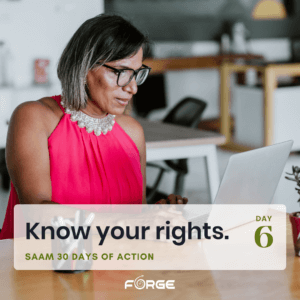 Legal rights for trans/nonbinary communities and for sexual assault survivors are rapidly changing in the United States. Legal rights also vary between jurisdictions. It can be difficult to stay informed on the latest developments, let alone without becoming overwhelmed.
Legal rights for trans/nonbinary communities and for sexual assault survivors are rapidly changing in the United States. Legal rights also vary between jurisdictions. It can be difficult to stay informed on the latest developments, let alone without becoming overwhelmed.
Trauma can disrupt a person’s daily living in significant ways. Knowing what rights a person has, can help provide a framework of comfort, when trauma has upended a sense of order and taken away a person’s right to not be harmed. Knowing legal rights can help survivors navigate the complex systems they face and maintain access to their basic needs.
Survivors’ rights include maintaining access to many resources and services. Just a few examples include:
- The right not to be discriminated against on the basis of sex/gender in education
- The right to safety at school
- The right and ability to access food and safe water
- The right and ability to access to a fair legal justice system
- The right and ability to access to the same or equivalent services as other people (for example, civil rights protections do allow for some sex specific services, but require equivalent/comparable services be available to everyone)
- The right to a forensic exam without involving law enforcement and without any financial cost to the survivor
- The right to be treated with respect (including about your gender, gender identity, gender expression, and sexual orientation)
- The right for people to use your correct name and pronoun
Some of these rights are specific to a person’s experience with violence. For example, a landlord should not be able to kick a person out of their housing when a crime was committed against that person. (Landlords sometimes attempt to evict a tenant, saying that the survivor was disruptive because a partner was violent or loud, or that the police came to the residence.)
Through Title IX, survivors have rights to continuing access to education after an assault and to safety at their schools. Depending on location, trans/nonbinary people have the right to be called by their name/pronoun, to gain access to services, and to not be discriminated against.
What can you do?
We can all affirm to survivors their worth and dignity – no matter what the law says.
Everyone:
Everyone can help by staying up to date on policies and advocating for protections for trans/nonbinary survivors. Friends or family may help by seeking out information so that the survivor doesn’t have to. Navigating the complex landscape of legal rights and resources can be difficult. Sexual assault agencies and coalitions are often informed about the rights of survivors in their jurisdictions and may have additional resources about legal aid services that are available. Not all sexual assault organizations are well-informed on trans/nonbinary issues, however. The members of the National Coalition of Anti-Violence Programs can be a good place to start looking for local providers. Find that list here: https://avp.org/ncavp-members/
Find sexual assault resources in your area here: https://www.nsvrc.org/organizations or https://centers.rainn.org/
All community members can also advocate for stronger legal protections for trans/nonbinary survivors. Encourage workplaces to increase their protections and support for survivors. Ask your employers about their policies and practices, even when you don’t need them, which will help to create more workplace protections for all employees.
Service providers:
Stay informed about the legal rights of trans/nonbinary survivors in your area. In addition to state and federal protections (or lack thereof), organizations and providers may look at their own policies and practices. What policies do you have that ensure the rights of trans/nonbinary survivors are respected? How can you go above and beyond the minimum protections to create a welcoming, inclusive environment?
Service providers can be transparent about their own organizational policies as well as the local applicable laws. Sharing a lack of knowledge (but a willingness to learn more), helps build trust with clients, and acknowledges that you will work diligently to support them whether there are formal protections or not.
Additionally, organizations should look at the rights of their own employees. Do your employees have access to paid leave, so that they can deal with the impacts of violence or vicarious trauma? Do you have non-violence policies to ensure your employees are not abusive? Do your HR policies include that everyone should be called by their name, regardless of what their legal paperwork says? Does your organization have trans-inclusive health insurance that creates healthcare equity across all employees?
Survivors:
Remind yourself that you deserve care and compassion. While there are some legal protections, you get to decide for yourself what you want to advocate for and what you don’t. You get to decide for yourself when and how to ask for help. There are legal aid organizations and others that may be able to help you access your legal rights – often at no cost to you. Remember, you deserve to be treated with respect and access respectful, inclusive services.
Many different organizations track national and state policies that impact legal rights. Check out:
- For trans legal rights by category: https://transequality.org/know-your-rights
- For a map of trans legal rights: https://transgenderlawcenter.org/equalitymap
- For state laws related to sexual violence: https://apps.rainn.org/policy/?&_ga=2.33479486.1638007035.1679423634-613179109.1679326777#report-generator
- State guide on workplace rights for survivors: https://www.workplacesrespond.org/resource-library/state-guide/
- Housing Rights for Survivors of Domestic and Sexual Violence: https://www.nhlp.org/initiatives/protections-for-survivors-of-domestic-and-sexual-violence/
- For information about legal rights to reproductive healthcare: ReproLegalHotline.org
- FORGE’s resources on sexual harassment and workplace discrimination can be found here: https://forge-forward.org/collections/sexual-harassment/
Weds, April 5th: Understand our differences.
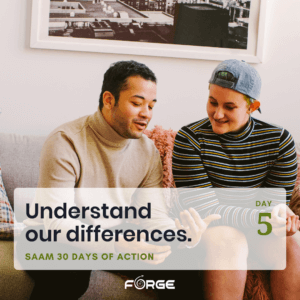 The world is a better place when each of us can be our authentic selves. As we shine our own unique light, we can also embrace the authentic selves of others. One way we can do that is to not box each other in with labels or other narrow perceptions of who others are.
The world is a better place when each of us can be our authentic selves. As we shine our own unique light, we can also embrace the authentic selves of others. One way we can do that is to not box each other in with labels or other narrow perceptions of who others are.
Every human is a complete, complex, unique person with their own gender(s), experiences, thoughts, and life. We often have so much in common with other people, other survivors, members of our communities and different communities. At the same time, it is valuable to all of us to understand and celebrate our differences. Even within a community that shares at least one identity, people experience that identity differently.
All too often, when we live in our truth, others sometimes create environments that are unsafe and dangerous to us – or a whole group of people like us. Unfortunately, we are living in a time right now where a lot of us are or feel unsafe. Some people have been targeted and assaulted by others because of their difference (or assumed difference). Some people have been ridiculed, harassed, or misunderstood because others did not try to understand or respect their differences.
Research estimates that 66% of trans/nonbinary people have experienced sexual violence. There is a lot that we know about sexual violence in general, and we know that each person’s experience(s) is unique. By taking time to listen for our differences, without judgement, we can support all survivors.
When we can all see the humanity in all people, whether we identify like them or not, whether we understand their lives or not, we make huge steps towards ending violence. You do not have to live someone else’s life to be present with their pain, their joy, and their fullness. We support survivors when we honor our differences – different experiences of harm and of healing. By supporting each person to be themselves, we can empower our communities.We Choose All of Us is a campaign started in Idaho that shares values of connection and belonging to bring about a safer world. Check out their ideas for one example of how we can celebrate our differences and come together.
What can you do?
Survivors:
Embrace and explore your own identities. Respect the ways others are different than you, this could include genders, race, personality, or experiences of harm and healing.
If someone shares a story of assault, you don’t need to compare your experience to theirs. You can both have experienced trauma and healing – even when those things don’t look the same. Sometimes, saying “that happened to me too,” can be validating. Other times it can feel dismissive because while something similar happened – it wasn’t the same. Check in with others on how they would like to connect. Check in with yourself too about how you want to be seen and heard.
Service providers:
Learn about the communities you serve. Practice cultural humility by recognizing the strengths, values, and resources that come from our various cultures. Remember that there is no one right way to heal, no one way that assault happens, and no one way to be trans/nonbinary. Listen to the people you work with. Ask open-ended, non-invasive questions that support people to express their full selves.
Work to learn about different resources in your community. For example, people working in mental health may want to become familiar with a wide array of healing arts practitioners in the area (when available) so that you can help connect people to the tools that work for them.
Consider what communities have been unserved or underserved in your area and why that may be. Equity calls on us to ensure that not only are resources available to everyone, but those resources should be what people actually need and want for themselves. This is not work that we can do alone. Connect with others in your community. This guide can help you to learn more about building meaningful collaborations: https://vawnet.org/material/collective-power-practical-blueprint-sexual-assault-programs-create-community-partnerships
Everyone:
Take time to explore your own identities and those of others. Read books, listen to music, watch TV about people similar to and different from you. Some aspects of our histories and cultures may be harder to find information about. Maybe books about your communities have been banned or kept out of schools. Noticing what you have been taught about who you are can help recognize shame, pride, and other complex feelings related to our identities.
Listen to different experiences without trying to make it fit into your life. We do not have to understand someone in order to respect their humanity. Due to systemic inequalities, you may hear from people who have had to face different barriers or challenges in their life than you did- maybe fewer, maybe more, maybe just different ones.
Tues, April 4: Provide trans/nonbinary-affirming services.
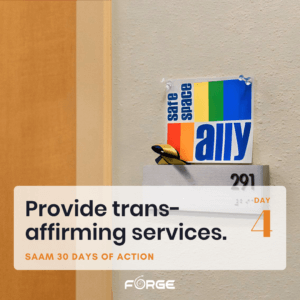 According to the 2015 US Trans Survey, 23% of transgender people avoided seeking healthcare in the past year due to fear of being mistreated. Unfortunately, this avoidance is based on very real experiences of discrimination and harassment in healthcare settings. In the same study, 33% of transgender people had negative experiences with healthcare providers in the past year: “This included having to teach the provider about transgender people in order to receive appropriate care (24%), being asked invasive or unnecessary questions about being transgender not related to the reason for the visit (15%), or being refused transition-related health care (8%)” (2015 USTS).
According to the 2015 US Trans Survey, 23% of transgender people avoided seeking healthcare in the past year due to fear of being mistreated. Unfortunately, this avoidance is based on very real experiences of discrimination and harassment in healthcare settings. In the same study, 33% of transgender people had negative experiences with healthcare providers in the past year: “This included having to teach the provider about transgender people in order to receive appropriate care (24%), being asked invasive or unnecessary questions about being transgender not related to the reason for the visit (15%), or being refused transition-related health care (8%)” (2015 USTS).
Trans and nonbinary survivors of sexual violence may avoid seeking post-assault care because of fears of mistreatment or past negative experiences. This is not necessarily restricted to healthcare. 70% of trans people who stayed in a homeless shelter experienced mistreatment related to their trans identity. Trans survivors often struggle to access support groups because of gendered restrictions on who is welcome, and many trans survivors have had negative experiences while seeing a therapist to process trauma resulting from abuse or assault.
When trans survivors work with trans-affirming service providers, the positive impacts on mental health, physical health, and wellbeing can be difficult to measure:
“I felt very heard and very believed and like I was in very capable hands.”
Even small signals of support, like trans-affirming signs or stickers, can make a big difference:
“Even a small tiny sticker means the world to me … and it doesn’t necessarily mean everyone in that clinic is positive, but it means that … somebody’s thinking about this and they care enough to put that there and they care enough to at least create a space that’s a little bit safer.”
Service providers can make a difference by taking steps to ensure that their services and agency are welcoming to trans and nonbinary survivors. Here are some strategies and resources for better serving trans survivors!
What can you do?
Service providers:
There are many ways to make your services more trans/nonbinary-affirming. Some strategies for making your services or practice more welcoming to trans and nonbinary survivors include advocating for all-gender bathrooms at your workplace, normalizing the practice of introducing yourself with pronouns and asking for pronouns, taking a harm-reduction approach to care, generating accountability and repairing practices for when things go wrong, creating a referral network of other trans/nonbinary affirming providers, and putting up visibly trans-affirming signs around your office or workplace.
Learn more about trans-affirming therapy practices in these two panel discussions:
https://youtu.be/pt40D6eD0WY
https://youtu.be/00KOaVsVEKY
Complete this self-assessment tool: “Is Your Agency Ready to Serve Transgender and Nonbinary Clients?” https://forge-forward.org/resource/self-assessment-tool/
Learn about implicit and explicit barriers to trans-welcoming services: https://forge-forward.org/resource/implicit-and-explicit-bias/
Watch the webinar: “Care, compassion, and creativity: Trans survivors and forensic exams” https://forge-forward.org/resource/care-compassion-and-creativity-trans-survivors-and-forensic-exams/
Learn about sheltering trans women, trans men, and nonbinary survivors.
Watch this webinar with ten easy and free steps every agency can take to be more trans-affirming: https://forge-forward.org/resource/becoming-a-trans-welcoming-agency-in-10-easy-and-free-steps-what-every-agency-can-do/
Mon, April 3: Believe survivors. Listen to survivors.
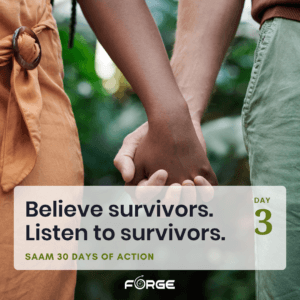 April is Sexual Assault Awareness Month. In April and all year round, we believe survivors. We listen to survivors. We invite others to do the same.
April is Sexual Assault Awareness Month. In April and all year round, we believe survivors. We listen to survivors. We invite others to do the same.
Studies show that at least 66% of trans/nonbinary people experience some form of sexual assault in their lifetime. These are staggering numbers. Throughout the month we’ll be posting 30 Days of Action focused on preventing and responding to sexual violence.
The place to start is by believing survivors. Many survivors find that when disclosing sexual abuse or assault, they are met with victim-blaming, doubt, or dismissal. By believing survivors we can better understand the impacts of sexual violence and support survivors to get the support they want and deserve. Trans/nonbinary people often experience additional layers of questions or doubt about what happened to them, with people asking about their gender identity or gender expression, which is often unrelated to the harm they experienced.
Believing trans/nonbinary survivors is vital to healing and creating a world where it is safe for anyone – of any gender identity – to share their experiences of sexual assault.
What can you do?
Survivors:
Believe yourself! You have the right to be believed, to share as much or as little as you want, and to control your own choices. You have the right to be treated with kindness and respect. Some survivors who deal with self-doubt find it helpful to find a person in their life who will repeatedly affirm them. Others may find it helpful to write an affirming message and put it somewhere you can see it regularly.
Survivors and loved ones:
Find affirming services. Check out FORGE’s resources to learn about some of the options available: https://forge-forward.org/collections/self-help/
The Trans Survivor blog also has many articles about survivors’ experiences with different forms of services and support.
Loved ones may help by calling resources for the survivor to find out if they are trans/nonbinary affirming and how they respond to sexual violence. This can ease some of the burden off of the survivor.
Service Providers:
Believe people about their experiences. Remember that disclosing assault can be very difficult for people to do. Take it seriously and treat all survivors with compassion. Start with FORGE’s webinar on creating a welcoming environment.
Think through the questions that you ask. Are your questions relevant to why the survivor is seeking services? Could they be putting the blame for the violence on the victim? If so, how can you reframe the question? What can you do instead to gather information that you need? This analysis can help you to demonstrate to trans/nonbinary survivors that you believe them and you are listening. Check out FORGE’s FAQ “Know and Tell Why” for more tips on how to gather information respectfully. https://forge-forward.org/resource/know-and-tell-why/
For everyone: Respond to disclosures with compassion. If someone tells you they were assaulted, you may say something like. “I’m sorry that happened to you. No one deserves to be treated that way. I believe you.”
Avoid things like, “Why were you there?” or “what did you do to make that happen?” or “are you sure?” These all imply that the victim/survivor was at fault in some way for the harm that was done to them.
Sun, April 2: Support Black trans lives.
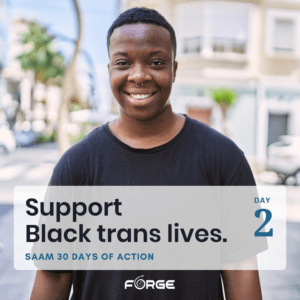 Black trans/nonbinary people are an integral part of our communities. Unfortunately, systems of inequality that have lasted for centuries are causing harm and increasing health and wellness disparities for Black people.
Black trans/nonbinary people are an integral part of our communities. Unfortunately, systems of inequality that have lasted for centuries are causing harm and increasing health and wellness disparities for Black people.
The Movement for Black Lives writes, “Discrimination, harassment, and violence against Black trans, intersex, queer, and gender nonconforming (LGBTQ+) people pervade virtually every institution and setting, including schools, workplaces, systems of policing, prisons, parole and probation, immigration, health care, and family and juvenile courts. As a result, Black LGBTQ+ people experience high levels of poverty, criminalization, health disparities, and exclusion in the U.S. .” https://m4bl.org/policy-platforms/end-the-war-trans/
We can all take action to address the systems of inequality that cause harm. By creating more equitable institutions we can begin to address some of the massive disparities facing Black trans/nonbinary communities. This means examining our laws, organizational policies and practices, and our own belief systems to ensure that we are working to challenge both anti-Black and anti-trans actions and beliefs. These steps create a more just world, something that benefits all our communities — Black, brown, and white; trans and non-trans.
What can you do?
Survivors:
Create time for Black trans joy. For many people, healing is hard work, and it needs opportunities to connect with joy, hope, creativity, and inspiration. Check out FORGE’s webinar from 2020: https://forge-forward.org/resource/black-and-brown-trans-joy/
Service Providers:
Recognize the whole person when you are working with someone. This includes understanding the increased likelihood of experiences of trauma, both individual and systemic that Black trans/nonbinary survivors may have. Racism has a negative impact on all aspects of a person’s life and well-being. It is critical that service providers are knowledgeable about racism and able to provide anti-racist services. This also means that providers should not see survivors through the lens of only the negative or traumatic experiences in their lives, but also be able to see and celebrate survivors’ culture(s), sense of self, joys, and full life experience.
Address internal policies and procedures to support staff. Many Black trans/nonbinary people face extensive job discrimination, and many survivors are excluded from work to support other survivors. Look at your workplace to assess how you can better hire and support Black trans/nonbinary staff. Partner with culturally specific programs in equitable ways.
Work on addressing your own biases. This webinar focuses on addressing anti-trans biases, and some of the skills may be applicable to address race-related bias. https://forge-forward.org/resource/implicit-and-explicit-bias/
Everyone:
Use your voice and political power. If you have the right to vote, vote for Black trans lives. Help others to access their political power through protests, engaging the legislative/political process, grassroots organizing or mutual aid. https://forge-forward.org/2020-11-01-day-01-blm-vote/
Learn about and work to end racism. Learn about the connection between racial inequality and health equity with the National Resource Center on Domestic Violence here: https://vawnet.org/news/how-can-domestic-and-sexual-violence-advocates-center-health-equity-black-women-our-work
Include the voices and experiences of Black trans/nonbinary people in social change work. The Transgender Law Center has a dynamic website section: Trans Agenda For Liberation. Check it out! https://transgenderlawcenter.org/trans-agenda-for-liberation
Sat, April 1: Connect the dots between preventing sexual violence and equity.
 Prevention demands equity. The National Sexual Violence Resource Center developed this theme for Sexual Assault Awareness Month with a call for racial equity and taking action to end oppression.
Prevention demands equity. The National Sexual Violence Resource Center developed this theme for Sexual Assault Awareness Month with a call for racial equity and taking action to end oppression.
Many of us know deep in our hearts that a more equitable and just world would have less interpersonal violence and less violence from systems. We feel that longing when we describe trans joy, when we talk about how we want to be treated, how we want all survivors to be treated. Research consistently supports this. The Centers for Disease Control and Prevention calls for better economic opportunities and equity, safe and supportive environments, and comprehensive prevention education as a few of the tools for preventing sexual and domestic violence.
Sexual violence happens for a number of reasons. In the United States, we live in a culture that is constantly telling us that it’s okay for some people to have power over others. We live in a world where groups of people have power over others and use that power to cause harm. We see people with power get away with violence on a regular basis. We are not taught to communicate kindly with each other. Many people are not taught to understand and respect “no”.
To prevent sexual violence, we need to address the conditions that make people commit acts of violence, and we need to change the conditions that make violence an easy or accessible choice for them. In the first category that means things like changing social norms so we discourage violence and encourage consent and communication, providing support for people to understand and manage their feelings and thoughts, and creating a world where everyone is valued. In the second category we start to look at changing our environment as well as our social norms. We may discourage violence through holding people accountable for their behavior. We also start to think about where and how violence happens. We work to create safer spaces where all people are valued.
For a long time, mainstream “prevention” efforts focused on reducing the risk for potential victims/survivors. Tips about not walking alone at night, tools for testing if our drinks have been drugged, warnings about red flags in relationships abound. These things can be empowering. They give us tools to think through our own choices and may reduce our risk for some kinds of violence in some situations. But too often these suggestions get used against victims and survivors. Survivors are asked why they left their drink alone, why they wore that outfit, why they existed out in the world.
It is critical that we have tools for safety planning without blaming victims for other people’s actions! Prevention efforts invite us to think about preventing perpetration and about creating a world with a less violent culture. The experiences of trans/nonbinary survivors add to our understanding of prevention.
What can you do?
Everyone:
Follow FORGE’s 30 Days of Action for a wide range of actions that you can take.
Learn more about the connections between equity, prevention, and sexual violence at: https://oaesv.org/where-we-stand/blog/2022/12/09/addressing-anti-lgbtq-violence-in-our-organizations/
https://www.preventconnect.org/2023/03/prevention-and-lgbtq-rights-opportunities-for-practitioners/
Examine your own relationships and behaviors to ensure you are not contributing to inequality and violence. Look for opportunities to increase inclusiveness. Check out FORGE’s resource on micro-inclusions for some ideas here: https://forge-forward.org/day-30-microinclusion/
Learn more about primary prevention of sexual and domestic violence. Both the National Resource Center on Domestic Violence and the National Sexual Violence Resource Center have resources on primary prevention. PreventConnect is a national resource with blogs, webinars, and other tools. The Centers for Disease Control and Prevention provides a public health framework for prevention.
Check out:
https://preventipv.org/
https://www.nsvrc.org/safety-prevention
https://www.preventconnect.org/
https://www.cdc.gov/violenceprevention/sexualviolence/prevention.html
